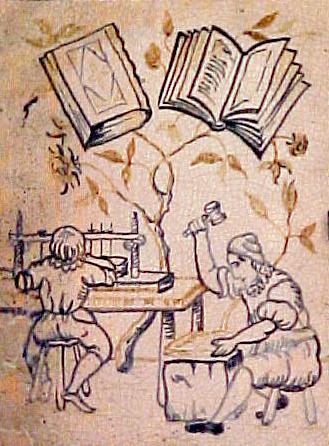
Practical Bookbinding
Morris Lee King
This essay was written principally for those who are interested in an amateur way in this subject or are contemplating taking it up, and at the same time are not able to come in contact with teachers of the art and others interested in it. I have not endeavored to cover the whole field, nor to go into the different methods in use in different countries. I have, however, endeavored to describe the processes through which a book passes from the moment the original casing is removed until it lies before us, well tooled, a thing of beauty.
Morris Lee King.
Editorial note:
First written in 1907 and 1908, this essay was never published in book form. It is presented here in its original text.
Copyright August 2001, bookbinding.com
The Beginning
BOOKBINDING in early times was carried on, the most part (as were so many for other useful industries), in connection with the religious orders. The monasteries were the chief centers for fine work in the way of illumination, hand-printed books and bindings of various kinds. The first good bindings of which I can find record came to Europe from the Levant?that is, from Arabia or Persia, gradually filtering through to Constantinople, to Italy, and so on, to France and Europe in general.
Before the art of printing was invented, however, bookbinding could scarcely be spoken of as having been widely known, because the only books then in use were printed with the pen, and copies were very scarce; they were to be found only in the possession of the monasteries and the very wealthy people of the time.
With the introduction of printing, however, binding became quite common, and early in the Middle Ages it developed into a fine art. The binders of those days, while they had more talent in the way of making designs appropriate to the text, did the technical work very crudely, the tools being made by the binders themselves, in many cases. This resulted in the finishing being done in what to-day would be considered a very haphazard and careless manner. At the same time these bindings still exist, and in many well preserved examples the condition of the finishing shows that it was not only solidly done, but that exceedingly good materials were used. It was Grolier, of Lyons, who first developed a special style of designs individual to himself. Many examples of his work are still extant, and his name is perpetuated by many societies of the present day. Since his day, binders of great repute have been more or less numerous, and various styles of bindings have been originated and are known by the names of such men as Le Gascon, Derome, the Brothers Eve, Jansen, Padeloup in France and Roger Payne in England.
During this formative period, leather was not as universally used as it is to-day, many bindings being made of wood, silver, velvet, cloth of gold and embroideries on various materials.
Of the modern French school, we need only mention a few names such as Trautz, Chambolle Duru, Gruel, Lortic, Marius-Michel, Ruban, and in England, Bedford, Zaehnsdorf, Riviere and Cobden-Sanderson. Aside from those mentioned, there are of course hosts of others, some of equal repute, as well as many who hope to achieve fame.
As the term “bookbinding” covers a variety of work, it is impossible in an article of this nature to treat it in all its varieties; so that it should be understood that the only kind of binding that will be here referred to is that known as ?extra first-class work,? and no attempt will be made to explain in detail the methods used in cheaper grades of work. Many of the processes described, however, may be used to advantage in simpler work; the extra expense involved, both as regards quality of material as well as extra cost of labor (owing to the time devoted to the work itself), is, however, prohibitive for ordinary commercial work.
Much of the work of the present day is well executed, as far as the technique is concerned, but many of the designs are imitations of the older and well known styles or inferior innovations. In many cases the books are over-decorated, owing to a desire to have a showy piece of work, this causing a loss of richness and dignity, due in many cases to over- decoration alone. Studying the work of the best binders of the 5th, 6th and 7th centuries, one gets much information, and by constant endeavor may finally acquire a style of one’s own.
During the last few years we have seen in our country, in connection with bookbinding, the development of a new class of art workers, who may he classified under the general term of amateurs. This term, however, does not accurately cover all the persons who are thus classified. Of course the real amateur is supposed to be a binder who is working for pleasure and not for profit.
There are comparatively few of these, however, for many so-called amateurs are really semiprofessionals, engaged more or less in the production of bindings for profit. This applies both to teachers and those who are not engaged in teaching. The net result, however, of the growth of interest in this country has been to develop a certain number of binders who do work of the first class.
This, taken in connection with the professional binders who do commercial work entirely, renders it unnecessary nowadays for the lover of good books to send them abroad to be bound. While the best work in this country equals that done abroad, there are comparatively few binders who are capable of producing work that measures up to the standard of the best foreign binders. Aside from the scarcity of first-class workers, we must consider the question of cost; and as labor of all kinds is better paid in this country, it follows that binders here cannot, as a matter of fact, compete in price with those abroad, and it may be that this is one of the reasons why so much work is still sent to foreign countries.
The amateur who begins work with a view to becoming a good binder should in every possible way cultivate a liking not only for the special work he undertakes, but also for allied lines of art, and will do well to observe the following maxims:
1st.. Learn to care for really well-bound books by familiarizing ones self with such bindings and with fine editions of good literature, worthy of fine bindings.
2d. To make careful study of the details of mechanism, beauty and adaptation of fine binding; and also to gain accurate knowledge of the discrepancies and dangers that beset inferior work.
3d. To make perfection the goal of every effort.
To do ones absolute best with every stroke of work, from least to greatest, and to condone no failures save through renewed knowledge, ability and effort to do better.
The simplest textbooks for a beginner are:
Bookbinding, by J. W. Zaehnsdorf, Bookbinding for Amateurs, by W. J. E. Crane. , Bookbinding and the Care of Books, by Douglas Cockerell. Brander Matthewss , Bookbindings, Old and New, may be consulted with pleasure and profit.
While not a technical handbook, it gives one a brief view of the history and styles of the art. These are inexpensive and may be had through any bookstore. One of the first questions asked by the seeker after knowledge along this line is, what constitutes the difference between a well bound book and the ordinary book of commerce? It is surprising how small the percentage is of persons who have any definite knowledge as to what the elements of a good binding are. Knowledge on this subject has spread very slightly, and only among a very limited class of people; so it is always necessary to explain carefully to the inquirer just what makes this difference. The binding of a book is described in the two technical terms, forwarding and finishing.
Forwarding covers collating, cleaning, sewing, backing, head-banding, putting on the leather, everything, in fact, that prepares the book for decorating and lettering. Finishing comprises the designing of cover decoration, tooling of sides and back, as well as whatever decoration is done on the inside of the cover.
The ordinary book of commerce, which is generally sold in boards with a cloth or paper cover, is really not bound at all. The book is sewn by machinery, and the cover, which is technically known as a casing, is also made by machinery, in many cases being applied by the same machine. The connection between this so-called cover and the book itself is of the very slightest nature. The tapes or cords on which the book is sewn are held to the cover simply by one thickness of paper, and in some instances by one thickness of crinoline. The book is not strongly sewn, and it has no head-bands, save in some instances a strip of material (manufactured by the yard) pasted on in lieu of the head-bands, this being an imitation of the real thing.
A well-bound book, on the other hand, is properly sewn with linen or silk on linen cords; these cords are laced into each board in so firm a manner that it is impossible to remove the board without cutting the cord or tearing the boards to pieces. The head-bands are then worked on the book itself, these being made of a strip of vellum standing on edge and entirely covered with silk thread, each head-hand being fastened to the book in from three to five places, thus becoming an integral part of the book itself when it is finished. The boards are then covered either entirely or in part with leather, which is a further strong connection between the cover and the book proper. The leather may either constitute a half, a three-quarters or a full binding. The book is then properly decorated either with a simple title or with whatever elaboration or decoration is desired.
HISTORY:
Training
While it is a very simple matter to enumerate the different steps through which a book passes, each step must be carried out very carefully and accurately, else the result will be other than first class. From the time a book is given to a binder to be put in full leather until it is completed, two months or more may elapse; depending entirely upon how much tooling is done. It is necessary that plenty of time be given the binder, in order that one process may not be too quickly followed by another. Good forwarding is absolutely necessary for good finishing. Each process should be carefully carried out, as one depends upon the other, and a serious defect in one step throws the volume out of the first class, even though the other steps be well done. In continental countries the apprenticeship system which is in vogue in all arts and crafts results in producing forwarders and finishers who have grown up in the business, so to speak. They usually begin as errand boys, in a shop, at ages from twelve years up, so that by the time they become full-fledged workmen they have spent from ten to fifteen years in becoming thoroughly familiar with every process and method in vogue at the time. They also go through a period of three or four years careful instruction, both in the shop and in technical schools, acquiring not only a technical knowledge of their own particular craft, but being instructed also in knowledge most essential to any accomplished artisan, such as the elements of design of all kinds, instruction in the historical characteristics of each particular period, and other points of a similar nature.
One sees, therefore, that the making of an accomplished workman under this system is not a matter of picking up a new occupation in the course of a few months; on the contrary, he chooses bookbinding as his life work and really grows up in its atmosphere. With us it is somewhat different; we have not yet reached the point where a young man selects an occupation or where it is selected for him in early youth, and he serves in it as an apprentice; on the other hand, change seems to be inherent in the American atmosphere. This applies to occupations of all kinds. In foreign countries a man almost never changes his occupation, and in many instances follows his fathers occupation as a matter of course. Here we see about us constant change of occupation, even after a man has spent years of his life in fitting himself for a certain line. This naturally results in less careful work in all branches of art and trade, and to a generally unsettled industrial condition. No apprenticeship system is in vogue here except to a very limited extent, so that we constantly see men and women following an occupation which they have picked up on the spur of the moment with more or less success. We have, however, a number of professional binders in this country, and these should be divided into two well-defined classes: those who earn their living by forwarding and finishing in establishments where they are employed year after year, and those who may be called semiprofessional who work more or less steadily at binding, earning part or perhaps the whole of their living thus, but who cannot be properly classified in the same category as regards skill with the professional workmen. In both classes, however, we have some exceedingly good workers, but I notice that the best of them are those who are foreign born and have therefore gone through a thorough course of training, or are, perhaps, men and women who have been able to spend years working by themselves or abroad, and have thus acquired great skill.
There is another large class, however, who have taken up binding more as a matter of interest and pleasure. In this class, also, there are some who have done exceedingly good work, but the great majority are less competent. Let us hope that the day will arrive when we will be able to include many of them in one of the other classes. Up to about fifty years ago good binding was hardly known in the United States, but with the spread of wealth and especially of the traveling habitwhich Americans have developed to such a great extent knowledge on this subject has been acquired and spread about. This has resulted in the formation of many societies whose members are interested in fine books and, as a corollary, good binding.
The greatest cause, however, of the widespread interest which exists today has been the formation of various arts and crafts societies in all parts of this country. The older ones have, in many instances, become a great power for the spread of art knowledge of all kinds, including that of bookbinding. Many of them have special schools where binding is taught. There are a number of leading publishing houses also which have departments devoted to the production of fine editions, both as regards printing and binding. Several of them have even established special departments in their commercial binderies for the purpose of producing extra-fine work. One house in particular which I have in mind, has gone to the expense of sending a student abroad for a number of years in order that he might qualify himself by instruction under the best foreign binders for the position of Director of Fine Bindings in that establishment. The Grolier Club of New York, noted for its production of finely printed books, also extended its usefulness, by establishing a special bindery under the name of the Club Bindery. This bindery, however, being solely under the control of the club, is not open to the public, as all work done there must be done for, or through one of the members. This bindery is noted for the production of uniformly beautiful work, which I believe is due, to a great extent, to the fact that the personnel comes almost entirely from France and England, where they had years of training in the best binderies.
General considerations: I have known of a number of instances where attempts have been made to begin bookbinding with incomplete or very unsatisfactory appliances. It is not possible to do first-class work with poor materials or with an incomplete outfit, though expert workers can get along and do good work with fewer appliances than the beginner. It should therefore never be attempted. It is not only unsatisfactory from the point of view of practice, but it is very discouraging to the beginner to find the best attempts result in poor work sometimes not due to any lack of ability or effort, but simply to lack of conveniences. It is better to become familiar gradually with what is and what is not needed, to accumulate tools slowly, but not to begin definite work until a somewhat complete outfit is at hand, and one has acquired by study of works on bookbinding, and by conversation with practical workers, some idea as to ways and methods. It would seem unnecessary to give advice of this kind, but, as a matter of fact, I have known of a number of instances where intelligent people have begun to work under these conditions and have as a result become discouraged unnecessarily.
Design & Tooling Design:
There is no question but that the design itself is of as much importance as the quality of the work. A striking but simple design, based on sound principles of art, is much more valuable and much more effective than more elaborate work done in a haphazard and in artistic manner.I think it will repay every beginner to acquire some knowledge of the principles of design and to continue the study, especially endeavoring to get reliable information on the special principles which should govern every design made for use in bookbinding. As in the engraving of tools, it is necessary that the maker of designs for bookbinding should know the limitations of tools and their combinations as used in this work. A prominent architect who was formerly much engaged in designing book covers and type lays down these opinions:
Tool forms should be clearly manifest, no matter how intricate their combinations. Richness of design is readily obtainable without over elaboration. The fewer the number of tools used, the better.
Ornament should always be subordinated to use. Modern rather than historical designing should be encouraged. I quote in this connection, also, some remarks made by Mr. Philip Mason, of the Riverside Press, Boston: “I find the ‘architectural point of view’ -if I may so name it- a valuable one in the application of ornament to leather-bound books.
First of all, I believe that the designer should himself be a practical ‘finisher’. In no other way can thorough appreciation be had of the possibilities and limitations of the tools themselves, which are the component parts of the design. The design should be made with the tools. But ability to sketch freehand is of the greatest advantage in making ordinary patterns. Very much the same conditions which make for restraint and orderliness in architectural detail will be found to apply in the decoration of bindings.
Varying ‘textures’ and contrasting degrees of reflection are desirable and beautiful in gold tooling. The relation between the decorated and the undecorated surfaces should be carefully studied. Not infrequently, in an ineffective design, the unpleasant shape of the undecorated surface asserts itself in a way damaging to the decorated surface considered as a whole. It is a question whether the most pleasing of richly decorated bindings are not those whose elements of design-in other words, the ‘tools’are few in number and simple of form. Application of design (blinding-in): One of the principal things to be observed in the application of a design is to have it square on the board-that is, the outside lines should be absolutely parallel with the edges of the cover, which I note is frequently not the case. The slightest deviation from absolute parallelism will be apparent when the work is finished. It is not advisable, therefore, to “blind-in” the outside line or lines through the pattern. This outside line or lines should be marked on the leather itself with compass and folder and should be “blinded-in” separately. The paper pattern should then be cut to fit this line precisely, laid on the cover, and held by a weight at center; several spots at edges and corners should be touched with paste and the edges then pressed into the lines already made.
After it has dried, each portion of the design should be gone over with moderately hot tools-a moderate amount of pressure being used. After this is done one side of the design should be loosened by running the folder under the edge (after the pasted spots have been moistened), so that the worker may assure himself that all parts of the pattern have been impressed on the leather. After the whole pattern has been impressed the design is removed, great care being taken to immediately wash off any paste spots which may be left. The whole pattern has then to be gone over again with tools which are quite hot, being careful to apply them accurately in order not to “double” the pattern. After having gone over them a second time, it will be seen that the pattern is very clearly indicated, and it is now ready for the final “blinding-in”. Up to this point you will note that the leather has been worked in its dry condition. Careful inspection will show that the leather just outside the edges of each impression is “pulled down” toward the impression, instead of being at its normal level, and making a clear cut impression for each part of the design. In order to correct this and to render permanent the impression already made, it is necessary to dampen the design with vinegar, allowing from fifteen to twenty minutes to soak in thoroughly; the whole pattern is now worked over again, this time with more care, if possible, than before, and with tools which are not too hot to rest against the hand.
Much care must be taken as to the heat of the tools during this operation, because the slightest excess of heat, combined with pressure, will cut through the leather, or at least burn it, so that the pattern may be spoiled. The principal reason why it is necessary to moisten the leather and go over the pattern again is, that if this is not done, the impression “blinded-in” on the dry leather would almost fade away on the application of any moisture, such as “glaire,” or at least become so indistinct that precise tooling would be impossible. It cannot be too forcibly impressed on the worker that careful, precise “blinding-in” is absolutely indispensable. The final results of thorough “blinding-in”, over careless work, are very similar to the results attained by the careful as against the careless cultivator. The one cultivates his land thoroughly, going over it again and again, to put it into the very best condition for producing good crops. The other is satisfied with careless preparation of the ground, and the result is that his crops not only are small, as regards quantity, but poor, as regards quality. The same thing applies to thorough and superficial work as regards the operation of blinding-in. Blinding-in of back: All designs for panels of back should be laid out from a central perpendicular line.
Having laid out the pattern, the paper is cut at top and bottom of panel, three and four inches being left at each side. Place the book- a pressing-board on each side-in the finishing press. With a folder make a slight mark on each panel at the exact center of back. The paper strip with panel design is now laid across one panel and the center line of the pattern adjusted accurately to the guide marks just made on the latter. Holding it firmly in place, the ends of the strip are touched with paste and fastened to the sides of the pressing-boards. It is now blinded-in, and the other panels treated the same way. The lettering on the back should also be laid out accurately on a similar strip of paper and blinded-in most carefully; much care should be taken to have it in the exact center of the back. Blind tooling: This is also known as “antique” monastic style. Blind tooling is simply blinding- in the design (as if for gold work), and instead of using gold, changing the color of the leather itself (in the impressions) to a brown or black. This is done by dampening the leather after the design has been impressed and going over the damp design again and again with tools warm, but not hot, the object being to outline the design either in brown or black. This is really done by singeing or scorching the leather under the tools. The color and depth of the pattern or design should be uniform over the whole pattern. When the blind tooling is completed, let the cover dry thoroughly, and then work the design again with tools much hotter than before; this polishes the leather in the impressions.
Studio, Machines and Tools Space needed:
Living in a crowded city as I do, and seeing a good deal of work done by others where space is valuable, I have of necessity devoted considerable thought to economy of space. While this is not a matter of importance to all, still I think a majority of amateurs are obliged to consider the question. We are not all fortunate enough to have a special workshop. All the work that I have done has been accomplished on two tables or benches, four feet long by two feet wide, fixed in front of two windows.
Three feet is a convenient height, but this depends upon the height of the worker. One table is devoted to forwarding, and has under it shelves and racks for holding pressing-boards, paring stones and the miscellaneous paraphernalia needed. The edge next the window has a raised ledge of six or eight inches, on which are arranged knives, straight-edges, etc. The other table, used mainly for finishing, holds the gas stove, etc. Above it on a side wall a small set of shelves gives room for the various small items needed in this branch of the work. This table has a number of drawers for storage of papers, leathers, gold cushions, etc. The raised back edge of the forwarding table, with an adjustable support on the front edge, holds the cutting-press when in use. This is not convenient, however. When possible, the usual “tub” should be on hand for daily use. The press, be it the usual standing-press or a strong letter-press, must stand on the floor or on a separate block. Almost all the processes of binding may be carried on by artificial light, but in this case it is well to have two lights, so as to avoid strong shadows. I advise strongly, however, against using finishing tools under artificial light. It can be done, but it is difficult and not satisfactory even for an expert worker.
Tools and necessary appliances: The most important thing is the cutting-press and plough. The standard size made for use in commercial work of all sizes, is too heavy and clumsy to be used by a beginner. A smaller size is made and may be ordered through the regular dealers. It is much lighter and is easily handled and answers all purposes, as it takes books up to sixteen inches in length. The price is the same as for the standard size. As it is always made to order, it takes a few weeks to get it.

TOOLS: 1 and 3, Fillets; 2, Agate Furnisher; 4 Hammer; 5 and 6, Metal Burnishers; 7, Band Nippers; 8 and 15, Paring Knives; 9 and 14, Paper Knives; 10 and 11 Compasses; 12, Paste Brush; 17 and 18, Drawing Tools; 19, Gold Knife; 13 Pattern for cutting corners of leather in covering

The standing-press may be of wood or steel and ranges in price from twenty dollars up. An amateur may, however, get along very well with a strong letter-press. I know of a number of amateurs in New York who are doing good work and who use only a letter-press. Another amateur living in the suburbs has converted to her use a small press formerly used in a cider mill.
Finishing Press: A press of this variety, 14 to 16 inches between the screws is ample for the beginner. It should be lined with skiver on the inside and on the upper surface. This is convenient in many ways, especially when small books are being handled.
Skiver is the inner or flesh surface of the skin which is left ,when leather is “split.” It is very useful for many purposes and can he had for a trifle Knives of various kinds are needed as follows:
Paring knives: Two at least are needed, the one most useful is shaped as shown in the illustration (a); another shown at (b) is known as the French style, and is very useful in paring out backs and also for finishing the paring of edges; it renders them more even. One knife, to be kept only for the cutting of paper, of the shape indicated herewith should be in the knife rack. Only the rounded edge should be sharp. One or two knives with blades of this shape should be provided, also, for miscellaneous use.
Whetstones: All cutting apparatus should be kept in good condition, as a torn edge of an end paper, a section, a piece of leather, caused by a dull knife, may result in hours of irritating repair work, and even then be unsatisfactory. One good oilstone and an ordinary whetstone (to be used with water or dry), a strip of sole leather, 2 or 2 1/2~ by 14 inches, coated with oil and fine emery powder, are necessary. The other laid on the table when paring, one end under the right edge of the paring-stone, is in constant use when paring leather.
While it is necessary to have knives ground only from time to time, it is constantly necessary to sharpen up the edges, and even a novice may learn in a short time how to use all the above. It is absolutely necessary to know how in order to save ones self constant annoyance.
Machines, Tools & Supplies
Covering pad: When leather is well moistened it is easily marred by rough handling or contact with any hard object. Putting in leather should be done on a soft surface. It is well, therefore, to cover a full-sized sheet of mill-board with a thick piece of skiver. Place this on the bench and rest the book on it when putting on the leather. A hole cut through one edge allows it to be hung on the wall when not in use.
Burnishers: The sizes most useful are 9 by 12 inch, 12 by 24 , but one can get along with one only. (See illustration.) Another (see cut), covered with skiver, is most useful in laying out and blinding in the straight lines along the sides of the panels. With the back at the upper part, the cover is raised two inches or so to a level, a paperweight or similar object slipped under it. Having marked at head and tail where the outside lines of the panels are to come, a straight-edge is laid on the cover, and with a sharp folder the lines are marked on all the panels at once, so they are exactly inline. The ruler may also be used by the beginner for the preliminary blinding-in of these lines.
Two or three small but heavy weights are needed at all times. They may be small steel blocks such as are used in blocking presses, or of lead. The latter may be had at any large printers, being run out of old type metal. A very convenient size is 3 by 6 inches by 1 inch thick. They should be covered with skiver or stout paper. This is the technical name under which the various kinds of cardboard and pasteboard are known in the trade. There is a great difference in quality. The ordinary domestic board is not worth using for good work. The very best quality of domestic board may be used from time to time, but for really first-class work it is best to use the best grade of English or French board. Mill board is found in the market in bundles of 100 pounds, the number of sheets depending on the thickness of same. The size of the board is about the same (average 20 by 28 inches) in all cases, but the thickness varies very much and is known by numbers. These boards, both the domestic and the foreign qualities, can be purchased at various dealers in supplies of this nature in less than whole bundles, so that it is advisable for the beginner to get a few sheets each, say of numbers 63, ,30 and 21. As all boards should be lined before using, it is advisable for the amateur to do this at one time and line the whole stock in hand (if not too great a quantity) in order that they may be ready, and that this operation need not be done from time to time, as it is just as easy to line a number as it is to line one.
Sheets of plain white paper either an ordinary quality of writing paper or other good quality of light paperof the same size as the hoards should he spread on the table and the top one thoroughly pasted with a fairly thin paste. The board to be lined is stood up slanting in front of the operator, the sheet of pasted paper taken by two corners and laid against it. It may now be laid on the bench and smoothed out thoroughly with a brush or a soft pad. Should there be any wrinkles, the nearest corner may be lifted and then let fall back again, smoothing the wrinkles out at the same time. Each board as it is lined is stood up to dry. It will he found that after they have dried they are drawn towards the side lined and this lined side is the one which makes the inside of the cover. Some binders are in the habit of lining both sides of the hoard and in this case one side receives two thickness of paper the side which is covered with two thickness is the one which forms the inside of the cover. A double lining of this kind is also useful when the board is slightly too thin for the purpose intended, and this strengthens it and also increases its thickness somewhat. This is a very important item in this work, it is necessary that it be of good quality and kept in good condition. The amateur worker will do well to purchase it or make it in small quantities only, so as to have it fresh at all times. Ordinarily paste is made by mixing flour and water and boiling it to a somewhat stiff consistency. The following methods are an improvement, however.
Paste for ordinary use: Take one-quarter pound white flour, one-half teaspoonful powdered alum; mix and stir in enough cold water to make a thin gruel. With a spoon or flat wooden spatula rub it up till all lumps have disappeared. Add cold water to make about a pint, and heat it i ly in an enameled saucepan. It should be brought slowly to the boiling point, stirring from time to time. Let it boil a few minutes, stirring briskly the while.
Paste for mending (Cockerell): One teaspoonful ordinary flour, two of corn meal, one-half teaspoonful of alum, cold water three ounces. Stir thoroughly with a wooden or bone spoon. Let it come to a boil slowly; it should be kept at the boiling point a few moments, stirring well at the same time; if too much heat is used it tends to turn it a dark color, so this should be avoided. A few grains of salicylic acid stirred in will aid in preventing it from turning sour.
Rice paste: Mix a few spoonfuls of rice flour with cold water and boil slowly. A little alum or a few grains of salicylic acid stirred in will keep it fresh a long time. Commercial paste: In all large centers paste is found on sale; this is made commercially for hinders use and may be had in small quantities. It is usually well prepared and is of good quality. In using paste the following points will he found useful to the beginner. Paste should always be kept in wooden, glass or enameled ware containers never in any vessel composed wholly or partly of metal. When thinning paste use water in small quantities and be sure to rub it up thoroughly, so that all lumps disappear and it is smooth. There is nothing more irritating than to be bothered (in the midst, perhaps, of a troublesome piece of work) with lumps, or loose hairs from your brush. Use a large brush for paste. Accustom yourself to take up paste on the second or third finger of right hand, and not on the index finger. It is often necessary to use the latter for other purposes at the same time. When pasting a narrow edge always place a clean straight edge of paper on the page, so as to expose only the part to be pasted. This makes a straight edge and protects the balance from soiling.
When pasting a number of edges at the same time, place them on each other and fan them out so that just enough of each edge is exposed; then place a strip of paper on the upper one (as explained above) and paste the lot. Paste should be used quite thick on leather and when pasting narrow margins, such as end-papers. For lining boards and pasting large surface of paper it should be thinner to run easily.
The majority of fine bindings are made of Levant morocco. Other kinds, such as seal, pigskin, etc., are used from time to time, but comparatively infrequently. There are many qualities of each kind of leather, but nothing but the first grade should be purchased. Although almost all of the better grades of Levant morocco are imported, we find that the American market does not as a rule receive the very finest grades of leather, these being used up in the country of their origin, and a comparatively small proportion is ever exported. At the same time leathers of a good quality can be purchased here. Some few years ago general complaint was made by librarians and others that the leather used of recent years deteriorated much more rapidly than that which was used in earlier times. An investigation was set on foot by the Society of Arts, and its report (for details see Bookbinding by Douglas Cockerell) showed that this was probably due to the introduction of chemical tanning processes instead of tanning by the use of vegetable products as in former times. Several leather manufacturers in England decided to change their methods and to produce leather which was tanned entirely by vegetable processes and this leather is known as acid-free leather, each skin being stamped to guarantee its quality. This leather does not cost materially more than a first class article of the ordinary type, so that it is advisable to use it wherever possible. This acid-free leather may be had now in New York, one of the members of the recently formed Guild of Book-Workers having it on sale. *As a matter of fact, the quality of materials used in fine bookbinding should always be of the first class, because the item of extra expense for each individual book, for materials alone, is so small, and the labor devoted to each hook so large a proportion of its ultimate value, that it is not worth while risking a good product by using anything but materials of the very best quality. Of recent years it has become quite customary to use leather which has been split; that is, a certain thickness (known as skiver ) is split off the inner surface of the skin by a very ingenious piece of machinery. The objections to split leathers are many; only a few need be mentioned: Much of the strength of the skin is sacrificed, and only the outer part of the skin, which has been hardened by the tanning process, is left. This is not so tough as the inner layers, which are also quite necessary to make a firm resisting medium for tooling. Again, even when split, the skin may still be too thick for a very small book and too thin for a heavy volume. The amateur is tempted to have his skins split, as he usually dislikes the drudgery of paring a thick cover. By selecting skins of varying natural thickness much unnecessary work of this kind may he avoided. When I began binding I had my skins split, as I liked the thinner leather not appreciating the damage I was doing and the difficulties I might have later on, in the way of unsatisfactory tooling, etc. I strongly advise the beginner to use leather of the natural thickness, providing himself with plenty of paring knives (of the very best quality), and to learn immediately how to pare a cover rapidly and properly it is not difficult under favorable conditions. Again, however thick the cover may seem when handling it, much of this thickness is lost when the book is squeezed (damp) in the press before tooling, to consolidate it and make a firm, smooth surface. I have seen leather lose from one-third to one-half its original thickness.
Preparing for Sewing
Trimming sections:
Books are often rebound where the sections have been irregularly folded, so that the fore edges and tail show great differences in depth of sections. It is necessary to trim them to some standard. After the sections are ready for sewing, take the book between the hands, knock the back straight, then reverse and do the same at the head, taking care to keep the book straight; then turn the head toward you, sight along the fore edge and select one section about midway in width between the widest one and the narrowest one ; take the section out and measure it accurately with compass from back to fore edge, then knock the book into shape again; sight along the tail and select another section to get the average height. Take this measure also.
We now have a standard for height and width, to which all sections should conform; none should exceed these measures, though some may of necessity fall short. We are now ready for trimming. If we have a regularly graduated paper- or board cutter, this is easily done; no machine, however, being the rule among amateurs, other methods must he used.
The following is simple, easily arranged and within the reach of everybody: A cutting board, or square of millboard, considerably larger than the section, is laid on the table. Two lines are drawn -A and B- at right angles (use steel square), and at the points indicated by X strong pins or fine wire brads are driven. Care must he taken that these pins stand straight and lean neither to the right nor to the left; the points should go through the lines not alongside. (It is preferable to use a sharp folder to make the lines, as pencil lines are always of varying width and should never be used when accurate measurements are required.) The line A being used as a base line, two points are determined (C C) by the measure previously selected as the standard for the width of the sections. Pins are driven here also. We are now ready for trimming the fore edge. Take one section at a time, place the back against the line A, head against the line B. Place a straight edge on fore edge of section, the straight-edge resting against points C C, and with a very sharp paper knife cut off whatever shows beyond the straight-edge. Some sections will fall short and need no trimming. The fore edge is thus equalized.

We now take two more points (D D), using the second measure previously decided upon as the standard for height. Drive two more pins here. Now place each section back against line B, head against line A. With the straight-edge resting upon the section as before, and against points D D, the tail of each section is trimmed, if it projects. Always keep the sections in their proper sequence. It will now be found on knocking the book into shape that the fore edge and tail present a more regular appearance. It is not desirable to cut much off the fore edge and tail (unless edges are to be full gilt), especially in books printed on hand-made papers.
In order to have a good surface to trim on, it is advisable to place a strip of zinc on the cutting line several strips of zinc of various widths and lengths are very useful to have on hand for this and similar purposes. The sections may also be trimmed by cutting a mill-board accurately the exact size decided upon, and placing it on each section in order; cut off the projecting edges. This method is satisfactory in expert hands, but the former gives better results in the long run. Beating: Binderies should be equipped with a heavy iron or stone heating block with a beating hammer. The amateur, however, may make shift to do with a heavy lithographic stone resting on a somewhat yielding bed, and the beating may he done with a heavy backing hammer. After the sections have been cleansed of glue and collated, the book should he thoroughly beaten in order to more completely consolidate itthis is especially necessary if it is a new book taken from the ordinary casing. If a thin book (say 1/2 to 1 inch in thickness), all the sections may be beaten at once. If thicker, half of it may be taken at one time. After each half is beaten, join them again and beat the whole book once more. Care must be taken to beat each portion evenly and strike squarely so the edge of the hammer-face never touches the sheetsif it does it will mar them. Beating should be practiced on some useless books. The sections may now be knocked up so the back and head are quite square, placing pressing tins between every five or six sections; the whole is then put in the standing press under the greatest possible pressure and left at least twelve hours.
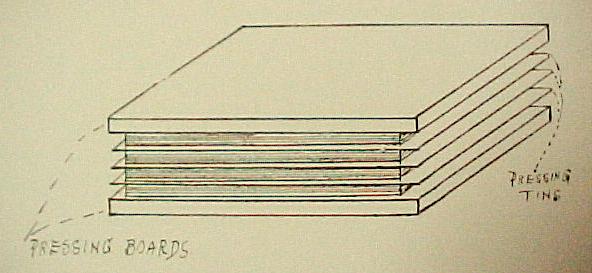
FORWARDING: Sewing

Three weights of Irish linen thread, Nos. 15, 18 and 25, will answer for almost all books. If there are many sections and they are thin, a light-weight thread is used. If the sections are thick, or very few in number, heavier thread may be used. It should always be borne in mind that the back will contain, when finished, as many threads as there are sections, and the back, when finished, should not be materially thicker than the rest of the book. Silk of various weights and colors may also be used in fine work; it should always be slightly waxed before using.
The book should now be knocked up between two pieces of board about the same size, the square being used on the head, to see that it is about square; it is then screwed in the cutting press. Old covers will be useful here. The back must now, by means of the compass, be divided into proper squares. It is customary to divide an ordinary octavo into six panels, making five bands, the four central spaces being equal to each other, the one at the head a trifle longer, the one at the tail a bit longer than the one at the head. Each binder may have his own ideas as to proportion and, indeed, as to number of hands. The points where the cords are to come being determined as above, the square is used and a heavy pencil mark made across all the sections where each cord will fall. If sunken cords are to he used and false bands made, then a fine-toothed thin saw is to be employed, sawing on the lines just made, until the saw-cut will barely show on the inside of each section when opened. Care must be taken that the cut be not too deep (better have it too shallow) and that it is not deeper on one side of the back than on the other.
If raised cords are to be used, no sawing-in is done; but it is very useful to make a shallow cut instead with a sharp, thin knife, so that less difficulty is experienced in finding just where the needle is to pass through the sections when sewing. Over handing outside sections, to give strength where most needed. The first and last section should now be over handed with fine linen thread, with stitches one-quarter inch apart. After this is done these sections should he placed on the beating stone and tapped slightly to bury the threads somewhat in the paper. Kettle-stitch: For both styles of sewing, however, a mark must also be made about one-half inch from head and tail and also sawn (but very slightly). These are for the turn of the thread in sewing, making what is known as the kettle-stitch. The sewing frame is now prepared. If the book is sawn in, thin linen cords are used; if not sawn in, heavy English or Italian cord is needed. The number of cords in each case is the same. The proper number of cords are now fastened in the frame and tightened up (see diagram).
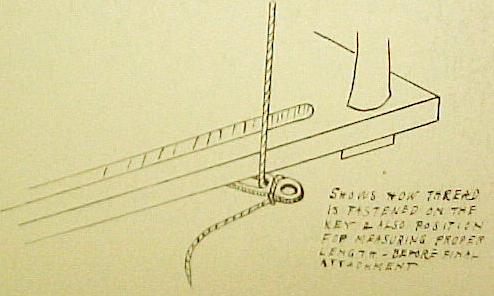
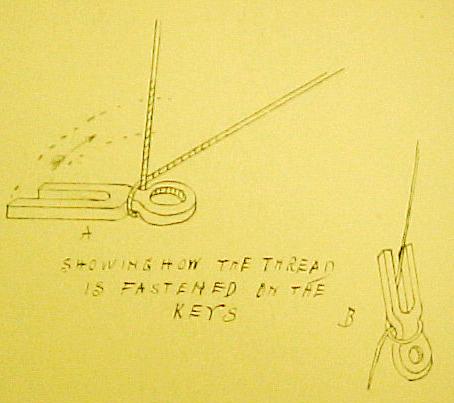
Place against the cords a thick pressing board, larger than the book to be sewn, so that the first section is raised up somewhat and handled more easily. The first section, being over-handed, is quite difficult to sew. It should be opened in the center and the needle passed through from center to back wherever a cord is to come (this preliminary work makes it more easy to pass the needle when sewing). Now lay this section, face down, on the frame, so the cords lie against the marks or cuts made on the section. The cords are to be adjusted to fit this spacing and then are tightened up. Sewing on sunken cords: As the operator sits before the frame the back of the section is toward him, head to the right. The left arm passing around or inside the left upright, as may be most convenient, the hand is placed in the center of section, holding it partly open; the right hand now passes the threaded needle into the kettle-stitch opening at head of section, is received by left hand and passed back through the first cut, the needle end coming out between the kettle-stitch and the first cord.

With the right it is now passed around the cord and back through the same cut. With the left hand it is again passed out through the next cut, around the cord and back, drawn up snugly from time to time so the cords are held tightly against the section, until it is finally passed out through the kettle-stitch opening at the tail. The next section is now laid on the first, held open with left hand, the needle passed through the kettle-stitch opening (next the tail), drawn up snugly and this section sewn as before.
Before passing to the remaining sections it is necessary to fasten the loose end of the thread which is still projecting from the first kettle-stitch opening. Steady the two sections with the left hand and pull each thread tight; then tie them together (they tie better if slightly moistened), cut off the original loose end and proceed with the sewing. The needle now being passed into thread drawn tight, it will be noted that this binds the ends of the three sections together. On emerging from the kettle-stitch at the tail of this section, the needle is passed between the second and first section (inside the thread lying in the cut for the kettle-stitch) and out toward the tail, the thread now forming a loop. Pass needle from below upward through loop and draw tight; this fastens the ends of these sections together. [sewing4.jpg] The ends of all sections must be tied to each other in this manner; but care must be taken not to draw the thread too tight, else the head and tail will be thinner than the central part of back, and will be so leaving a clean, straight strip of paste on the section. Let it set a moment or so, then bring the first section over, close it but do not use much pressure over the paste. Be sure the back edges of the two sections are quite evenly adjusted.
Treat the last section in a similar manner. Place the book between two pressing boards with a weight on it and leave for several hours, or overnight. The object of the two cardboard slips is to bring the weight on the pasted portion only and make a solid union. If this is not well done, it is liable to come apart when the book is opened. This also hides the thread used for Over-handing.
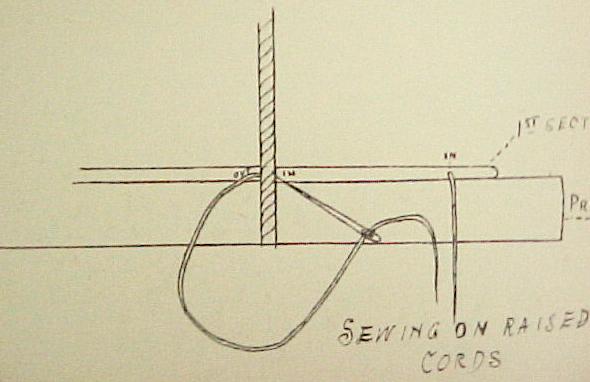
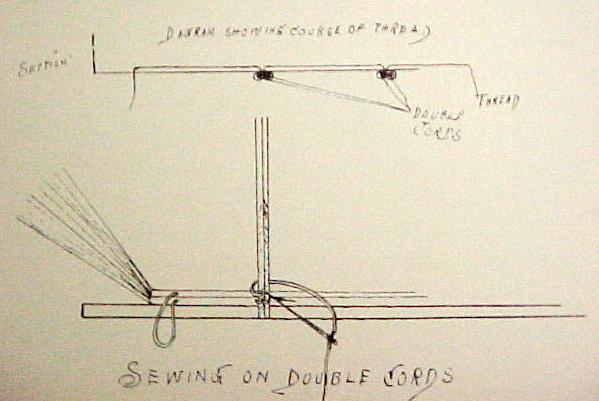
End papers;
These may be white, plain paper, as much like that of the printed page as possible, but often they are made of a colored paper harmonizing with the color of the leather used. While any firm paper of good quality may he used, it should be of tough fiber, so it will not give way in the hinge or during manipulation. Hand-made papers of many kinds are in the market. Of the best and most decorative are those known as the “Morris” papers of English manufacture. Having selected the quality to be used, cut two pieces, which, when folded, are somewhat wider in both directions (say one-half inch) than the section of the book. After folding them -with the plain side out- line one side with white paper like that of the book itself. This lining paper should reach not quite to the jolted edge. Leave a strip about one-eighth inch. Place between two sheets of blotting paper, give them a nip in the press and stand up to dry. Now take two pieces of the same paper just used for lining, fold them the same size as the endpapers, rub paste along one edge of the fold (a width of not more than three-sixteenths inch), paste carefully to the lined side of the end-papers, the two folds being in contact up to their extreme edges. The paste should be allowed to set a bit before sheets are stuck together placed between two pressing boards under a weight to dry thoroughly. If the weight is too great or if there is too much paste used, it may spread between the sheets more than is intended and this causes trouble later on. We now have the colored paper folded, one side lined and two more leaves of white paper on the lined side. Open the white sheet and fold the reverse way, so that one of the white leaves now covers the unlined part of the paper. Smooth the fold firmly with a bone folder. The white leaf just turned over is for the protection of the unlined colored leaf, and is torn off when the latter is pasted down on the inside of the cover.
The Cobden Sanderson method of making end-p apers is very ingenious and of great value. It is fully illustrated and described in Cockerells book, to which the reader is referred. Other methods of making end-papers are in use and can be learned by consulting the text-books referred to.
Pasting on the end-papers: These having already been prepared, one is to he pasted carefully on the first and last sections respectively. Each end-paper being folded (the two colored surfaces in contact) we find a white leaf covering the outer side of each colored leaf. As the unlined colored leaf is to be ultimately pasted down on the inside of the board, it is obvious that the paste should he applied to the other leaf; the folded edge should be covered with thick paste for a space say one-quarter inch in width and after it has set (a few minutes) it should be pasted on the section, being flush at the head and not coming quite to the back edge of the section itselfone-sixteenth of an inch or even less being allowed. After both end-papers have been adjusted, place the book between pressing-hoards, well weighted, and let them dry thoroughly. It is desirable that this connection be a most solid one, as it is subject to considerable strain.
Trimming the end-papers: These being usually somewhat larger than the sections, are trimmed after being pasted on .The exact width of the sections is taken as follows, with the compass (before the end-papers are pasted on), the book laying with back to the operator: Place the thumb nail perpendicularly against back of sections, rest one leg of compass against it, with the other at the fore edge.
This distance should be marked accurately on a thin strip of paper, for reference later. The end-paper being pasted on, place a cutting tin somewhat larger than the sections between it and the sections, take the above-described measure with a compass and with thumb nail against back, mark the fore edge of each end-paper, at upper and lower ends of hook by two points with straight-edge and knife cut through them; it will then be found that the edge is true with the edge of the section. Now lay the book on a cutting board, place a thin straight-edge between hook and lower end-paper at head, the straight-edge just showing along head of the section. Press down on the book to hold it steady and cut through, thus trimming the head of end paper. After both end papers have been thus trimmed at head and tail, the book is ready for:
Fraying out the cord:
Each cord is now freed of any glue which may have stuck to it, the strands untwisted and drawn between the finger and a knife-edge or bodkin; this results in separating the strands into the original fibers, and they now present a soft, fluffy appearance.
Rounding & Backing
The sections are now knocked up again, particular attention being paid to having the book quite square at the back and at the head. It is then laid on the edge of the bench between two pieces of mill hoard which come up flush with the backs of the sections, the cords being quite covered by the boards. A thin coating of hot glue is now applied, pressure being made on the upper mill board in order to keep the glue from penetrating between the sections. Always apply the glue from center of back, toward head and tail.
Now (allowing a short time for the glue to set) lay the book on a large lithographer’s stone (Or on the bench) with the fore edge toward the operator. By placing the left hand flat on the upper surface, thumb against fore edge of central sections, the upper sections may be drawn toward the front, tapping the back in the meantime with the backing hammer, which causes the upper half of the book to assume a rounded shape.
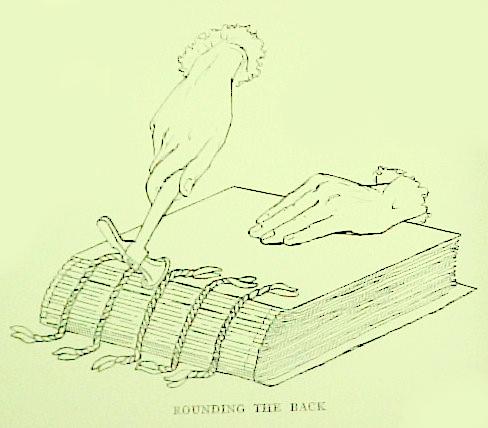
The book is then turned over and the same process gone through with on the other side and repeated until it is “rounded” properly (the glue used for this purpose is especially prepared and does not become as hard and unyielding as the ordinary article). The back now being “rounded,” the book is laid on the bench, back away from the operator.
Take one of the backing irons, slightly moisten its surface, place it on the book from one-sixteenth to one-eighth of an inch from the back edge; holding the book and the iron firmly together, turn them over and adjust the other iron, moistening it also. The edges of the irons should be quite parallel. The distance from the edge of sections depends altogether upon the thickness of the book and the proposed thickness of the cover. After having adjusted the backing irons, hold them tightly, so they will not become disarranged, and place in the lying press; great care being taken to keep them perfectly parallel. The press is then screwed up as tight as possible. The cords rest on the outer side of each backing iron and care must be taken not to strike them with the hammer, else they will be cut off. With the front edge of the backing hammer (the operator standing beside the press) the sections are knocked away from the center line of back, on each side, by tapping them gently. [backing.jpg] After this has been carefully done, the face of the hammer is used (the operator now standing at the head of the press) and with blows directed alternately toward each edge of the back, the sections are gradually beaten over to the left and to the right, this finally resulting in the sections on each side being beaten down, overlapping the sharp edge of the backing irons. When finished the back of the book should be perfectly round and solid. Taking the book out of the press, we find that we have formed what are called “joints” which should be just deep enough to take in the thickness of the the board which it is proposed to use for the cover.
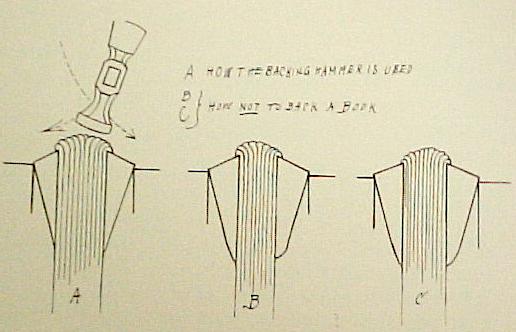
Putting in boards: The thickness of board appropriate to the book having been selected before the backing is done, they must now be cut to the proper size. Before doing this, each board is lined (if this has not yet been done), either on one or both sides with ordinary thin white paper. They may be lined only on one sidein which case one thickness of paper on one side only is sufficient. Again, they may be lined on both sides, in which case two thickness of paper are put on one side and one thickness on the otherthe side lined with double thickness forms the inside of the cover. This results in drawing the board on one side, the curved side always forming the inside of the cover. This drawing is necessary in order to offset the drawing qualities of the leather when it is put on the outside of the board in the process of covering.
After the boards are lined, and have become thoroughly dry, they should be cut to the proper size. Measurements for the covers should be taken before backing as follows: The book lying on the press, with the back toward the operator, the thumb-nail is placed against the back edge. With a compass (one leg resting against the thumb-nail) the distance from the back edge of the section to the front is taken. This constitutes the width of the board. Turning the book with the head toward the operator, and placing the thumb-nail against the head, the distance from the head of the section to the tail is then taken in a similar manner. An allowance is made for the “square” at the bottom of the book, which ranges from one-eighth to three-sixteenths of an inch or more, depending upon the size of the book. This should be added to the measurement last taken and this constitutes the length of the board.
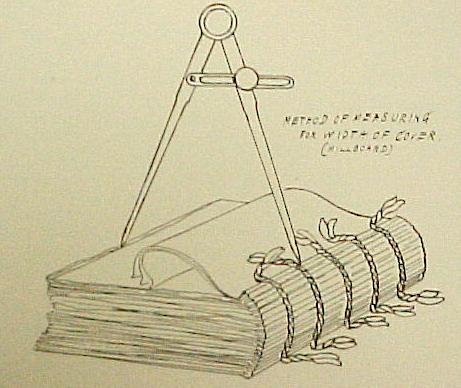
It will he noted that allowance has only been made for the “square” at the bottom of the book. The “square” at the head will be made later, by cutting the head of the book after it is placed in boards. The “square” of the fore edge of the book will be made during the process of backing, inasmuch as enough of the back edge of the section is taken up by this process to make the “square” of the fore edge. These measurements must be taken most accurately and must be accurately transferred in order that the boards may lie properly. The difference of one-sixteenth of an inch in a fine piece of work would render it very defective. The best way to transfer these measurements is to register them on a narrow strip of firm, substantial paper, the lines being made with the sharp edge of a bone folder.
It is always best to cut the two covers at one operation, the two boards being kept together while the four edges are being cut. All boards should be cut most accurately in the cutting press. Lay them out with an accurate steel square, and mark with knife-edge. In order to ascertain whether they are absolutely true after cutting, one board may be reversed on the other, so that the ends which were cut together are opposite each other. If there is the slightest difference in the two boards, this method will increase it so that it will be quite noticeable. If there is any material difference, it is better to cut a pair of new boards than to try to trim up the old ones. In all cases the boards should be cut with the lined sides in contact and should be marked on the inside so they may be placed in the same relative position when lacing them to the back. The boards may he laced on after cutting the back edge only, the remaining portion being cut to size after, just before putting in leather. I prefer the former method.
FORWARDING: Head-Bands, Single & Double
Edge gilding:
Edges may be “full gilt,” “gilt in the rough,” or only have the head gilt. Full gilt edges are not in common use; this style is mostly used in religious books and in very elaborate, showy publications. “Gilt in the rough” means that the rough edges of band-made paper are gilded untrimmed. Valuable editions, etc., are not trimmed, but gilded in the original sizes. This gilding is done before sewing. The style most popular is to have the head gilt, which is done principally for the purpose of catching the dust as the book stands upright on the shelves and allowing it to be easily rubbed off. The head should be gilded just after the boards are laced in and the head has been cut.
Gilding the head:
Throw the boards back, place gilding boards on each side of the head flush with the surface to be gilt; screw up very tightly in the press. (A regular gilding press is made, which has metal instead of wooden screws, which exert much greater pressure. The amateur can, however, get along with the lying press.) The head is scraped and sand-papered. Take a piece of gilder’s red chalk, rub with water on a stone, to make a somewhat thick paste, which must be thick enough not to run between the leaves. Apply it with a stiff brush (with short bristles). When dry, brush again with a stiff brush, which removes the superfluous chalk and polishes the edges somewhat. Glaire the whole, or part of it, and apply the gold-leaf (previously cut to proper size), and let it dry. In an hour or two it may be burnished with the agate burnisher. It is well to lay an oiled paper on the gold when beginning this operation. It may also be finished through this thin paper; it will then not be so bright, but rather of the “dead gold” order.
In commercial work, and also in much work done by private binders, edge-gilding is usually sent out to be done by houses which devote their entire time to this special work. I advise the beginner not to gild the edges of his own books for the time being, but to have it done by experts in that particular line. It is much more satisfactory, as a rule, than to do it ones self.
Head-banding:
This is one of the most troublesome operations which confront the beginner, and it is almost impossible to learn to become proficient in it without some personal instruction, or at least seeing some one else do it. The silk used for head-banding should be what is known as buttonhole twist, heavier than the ordinary. No. B E is not too heavy. The simplest head-band is made as follows: Two strips of vellum are cut (using very sharp knife and rule) slightly longer than the round of the back. The height of the strip should be a shade less than the width of the squares at the head and tail. These strips are made to assume the curve of the back by drawing them between the finger and a rounded surface, such as a lead pencil. The silk used for covering these strips of vellum is usually of two colors, though more colors may be used as one becomes expert. For the purposes of explanation, however, we will assume that two colors, red and white, are used. The book is to be placed in the finishing press or other convenient press, the head up, with the fore edge slanting toward the operator (see illustration).
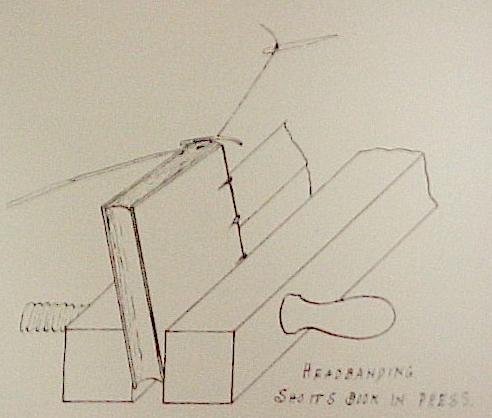
Two threads of silk are knotted together, and the red one threaded in a sharp pointed needle. Slip a bone folder between the leaves about five pages from front of book and pass needle through the back of book, just below the kettle-stitch. (The place where the needle is passed through the back is usually about one-half section from the front of the book.) As the thread is drawn through the back the knot is drawn between the leaves (to the front of the kettle stitch). The needle is then brought up over the head to the front, again passed through the same place, thus leaving a loop over the head of the book.
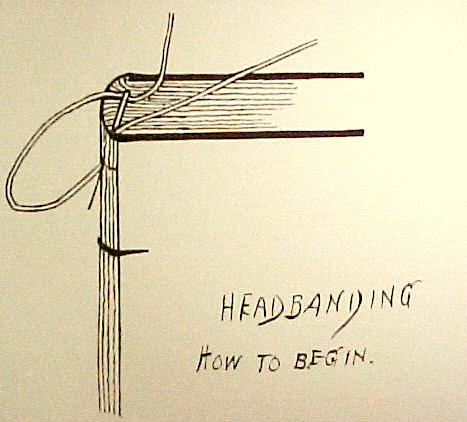
Through this loop is passed the little strip of vellum, the lower edge setting snugly on the head of the sections. The loop is then drawn tight, and this, aided with the finger holds the vellum strip upright in its proper position. By reference to the cuts it will be noted how the vellum strip may also be supported by sticking a pin or needle upright in the first section. We now bring the needle to the front again, which brings the red silk for the second time over the head-band alongside the first turn. By placing the forefinger of the left hand on this strand and holding it down on the head of the book (a little distance from the head-band), it is kept taut; with the right hand the white silk (coming up between the sections in front of the headband) is drawn over to the right over the red silk, slipped under the right-hand end of the vellum and drawn snugly down until the red silk, where it is crossed by the white, is drawn down to the junction of the edge of the strip and the head of the book. Still holding the red silk under slight tension with one finger, another finger of the left hand may be placed on the white silk (where it passes over the vellum) to hold it in place, while the end is again brought forward and again slipped under the vellum and the end brought over and down against the head of the book (as the red silk was); the red silk is then carried to the right, above the white, and slipped under the vellum as before, thus drawing the white silk to the junction of the vellum and the head of the book; then it is again brought forward and slipped once more under the right edge of the vellum, thus making two loops of red silk. The loose end of the red silk is brought forward and held to the head of the book, as before; the same operation is now repeated with the white and red silk alternately, until the head-band is finished.
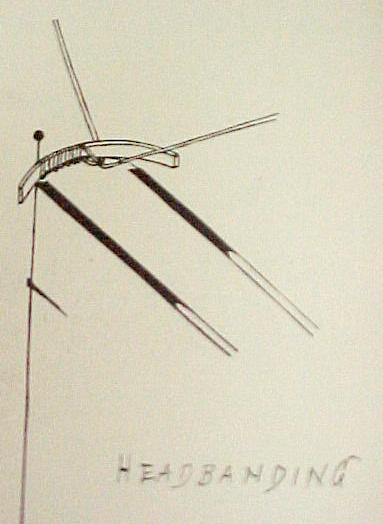
The principal points to be observed in this work are, to keep both silks under constant slight tension and to see that the bead formed, where the vellum rests on the sections, is regular and not tight. If any one portion does not seem regular, it may be pushed down with the edge of a folder. From time to time it is necessary to fasten the head-band to the book. This is done every one-half inch or so, by running the threaded needle down in the section and under the kettle-stitch and bringing it out through the back and up over the head-band, as in the beginning. This takes the place of one of the turns just described, and does not interfere with the general operation of making the head-band. When the right-hand edge of the back is reached the needle is passed below the kettle-stitch (within four or five pages of the end of the book) twice, just as it was in beginning the head-band. After the needle has come out at the back the second time it is passed under the two strands of silk which now extend from the head-hand to the kettle-stitch, on edge of the back, and then down through the loop which is formed, drawn tight, and cut off. The remaining end of white silk is drawn under the right-hand end of the vellum (between the lower edge of the vellum and the head of the book) and passed through the loop of red silk just before it is drawn tight. This holds both ends snugly. That they may not slip, a bit of glue or paste may be rubbed over them at this time. When this head-band is finished we find alternate rows of red and white silk (two threads each) with a beaded margin at the base, covering the junction of vellum and sections.
Double head-band:
This may be made of vellum or cord, as desired. The upper band should be the smaller both in height and thickness. Begin by making a loop (as in simple head-band) into which the lower cord or band is slipped, the thread then being drawn tight.

Place the upper segment in position, tying the left-hand ends together to hold it. Pass the needle between the two bands, make two turns about the upper band, leaving the needle end projecting between the bands (in front). Holding it taut, draw the other end across it, passing above and to the right and under the lower band. This draws the needle end down to the junction of the lower band and the sections and commences the “beading.”
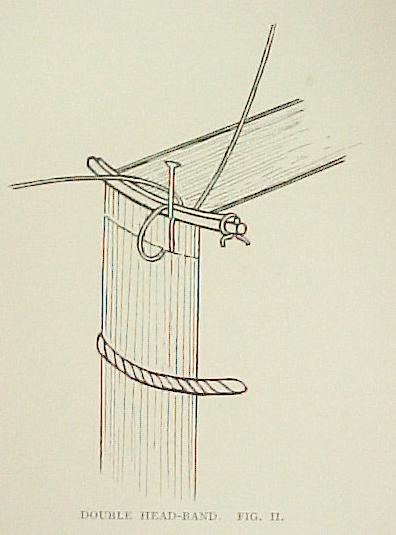
Now bring the end which has just passed under the band to the back, between the two bands, to the front, then once around the upper band, thus coming out again in front, between the two bands. The needle end is now passed across the loose end (above it) and towards the right, repeating this process as in the single head-band until it is finished.
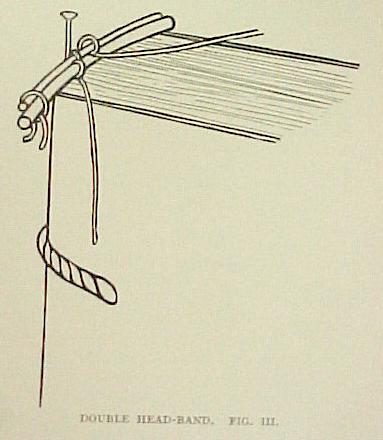
This style of head-band is fastened to the book in the same way as was described for the single head-band. The fastening down can only be done when the needle is brought in front, between the two bands, just after it has been wound about the upper segment. Pass the needle through the section coming out on back just below the kettle-stitch; bring it up and forward between the two bands and then wind around the upper segment. At the end, after the last fastening down, the two ends are drawn under the lower strip, cut off, frayed out a bit and pasted down.
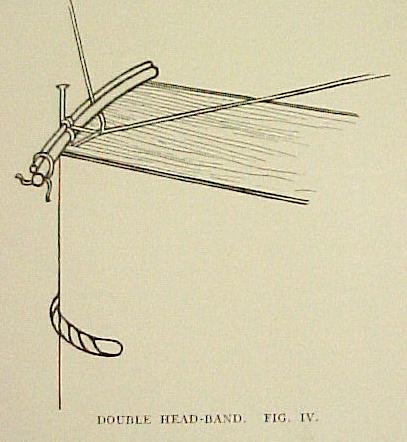
There are many varieties of head-bands, some made with several colors of silk, others made of two pieces of vellum; of a piece of vellum and a piece of catgut, lying in front of it.
The various illustrations give a fair idea as to how the silks are handled in making both single and double head-bands. Lining back: After the head-band has been made and fixed by rubbing a little glue on it at the back (thus fixing the threads to each other and the band to the upper edge of the back), the back is usually “lined.” This is for the purpose of strengthening it, and also, when false bands are used (when the book is sewn on sunken cords) to make a surface to which the bands may be glued. Place the book in the finishing press, cut a piece of paper (somewhat firm, like cartridge paper) an inch longer than the book and about five times the width of the back. Dampen one side by sponging slightly with water. Glue the back (head-bands and all) with thin, very hot glue; put the paper on the back, leaving exposed on one side a strip of the back about one-eighth inch wide; smooth the paper down well, fold it over the back again (the folded edge of the paper coming exactly at the edge of the back and parallel with the cover) the paper being smoothed down will also stick along the other edge of the back because of the strip of glue which was left uncovered in the beginning. Fold again at this edge, brush the back again with glue, and draw the paper again across the back. It is now well smoothed down with a folder and the remainder cut off smoothly along the joint. Thus we have three thickness of paper on the back, two thickness, however, lying against each other not glued. This is for the purpose of forming what is known as a “hollow” back. This arrangement allows the back to open without bending the leather and thus prevents the tooling being injured. After a short time the parts projecting, beyond the head and tail are cut off.
FORWARDING: putting in Boards & Trimming
Lacing in:
The boards now being cut to size, each edge of each board should be filed off somewhat, either with a coarse file or with a piece of fine sandpaper fastened to a small, flat piece of wood. This takes off the “burr” left from the cutting and also the sharp edge of the lining paper. Each board is now fitted in the groove where it is finally to be lacedthe head of the board being flush with the sections (cutting the head later will make the square). Place a weight on the board, take the first cord, hold it upright and at its center mark the edge of the board with knife or folder. Repeat this with each cord (mark the boards, if not already done, so each one will he returned to its proper side).
The marks for the cords should extend at right angles, say three-quarters of an inch toward the center of the board. Lay the board on a thick stone, marked side up and away from the operator, and flush with the further edge of the stone. With a rather large coarse file (12inch), file each mark made above, to a depth which will allow the cords to lie in it and be flush with the surface of the board. These grooves are necessarily deepest at the edge of the board, and gradually become shallower until they disappear.
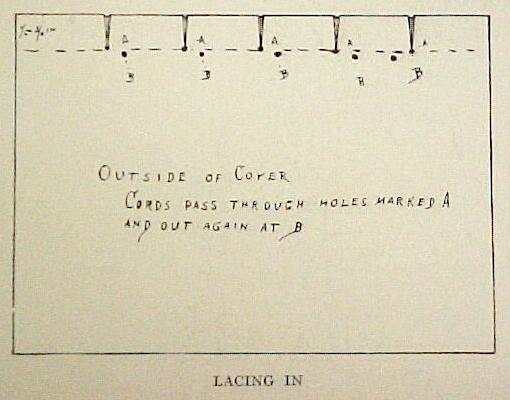
Now lay the board, grooves up, on a piece of wood or lead and with a pointed steel bodkin and hammer punch a hole in each groove at points shown at A. Reverse the board and make another set which come out at points marked B. Care should be taken not to smooth down the board around these holes where it has been pushed up by the passage of the bodkin. The cords being already frayed out, those on one side should be well pasted (to within one-half inch of the back). Holding each one near the loose end (only) is to be twisted to a point so it will easily pass through the holes just made. Place the book on the bench, back away from the operator. Raise the board at right angles to book, pass each cord through the holes A in the grooves, draw through and pass back again through the holes Beach one being drawn as snugly as possible. Now raise cover slightly and slip a heavy pressing tin on the sections under the cover, the edge, however, not quite reaching to the bottom of the groove or joint. Again raise the cover nearly to a right angle, push it into or against the joint; steady it with the chest. Each cord is again pulled as snugly as possible -especially the first and last- pressing the end (after it is pulled up snug) with one finger. When all are pulled tight, still pressing on the cord ends (to hold them taut), push the cover down flat. Still holding at least two of the ends with the left hand, tap the cords smartly with small hammer or end of knife handle, where they enter and emerge from the holes. This packs the board about the cords tightly enough to hold them in situ temporarily. Raise the end of each cord gently and cut off by running a sharp knife flat along the board, edge away from the back, so the real cords will not be cut accidentally.
Take the book in the left hand with one cover open at right angles to book, rest it on the beating stone or other solid bed (see illustration). With the backing hammer beat the cover over the holes until the surface is smooth to the touch and no raised spots are apparent. Care must be taken not to mar the board with the hammer edge. Turn the board over and hammer the holes on the inside until they also are smooth.
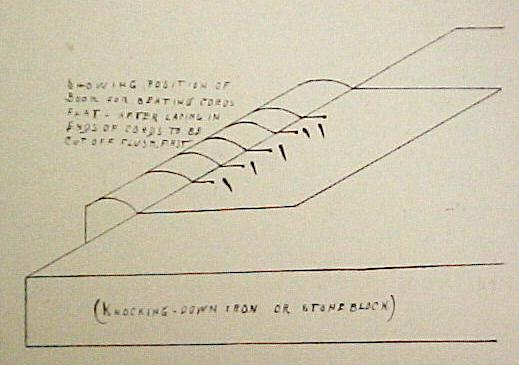
The cords are now anchored so strongly that they will break before pulling out. [lacing2.jpg] Cleaning off the back: After the lacing in is completed, the superfluous glue on the back may be removed by moistening it slightly with water, then rubbing it off with a sponge; care should be taken not to wet the edges of the boards. When well cleaned, glue should only be visible between the sections; the back should he quite clean and firm. Cutting the head: Slip a thin millboard between the head of the last section and the cover, flush with the cover. With the book lying head away from the operator, raise the front cover (to loosen the tension on the cords), slip it down, exposing enough of the sections to allow for the “square” at the head and close it again.
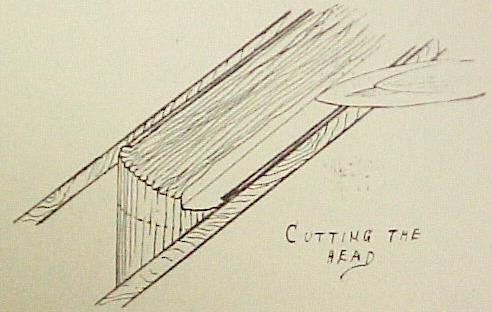
Now place the book in the cutting press, back toward the operator, the head of the front cover being flush with the cheek of the press. Be sure before screwing up the press that the two covers are quite parallel at the head, though not at the same level. [plough.jpg] With the plough cut the head, a few sheets only at each stroke, until the knife touches the slip of mill board which was inserted to protect the back cover. Cutting fore edge (in boards): The boards having been laced on, a mark is to be made (near head and tail of fore edge), with knife or folder, at edge of each board as a guide. After knocking the back as flat as possible, drop both boards away from the sections and slip a pair of trindles (see illustrations) between the back and the boards.
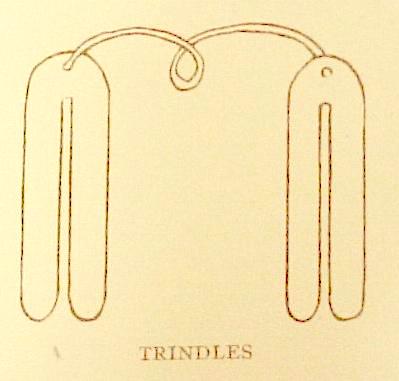
These trindles will keep the back flat until the sections can be snugly held by winding a tape around them. Now remove the trindles and place a cutting hoard on each side of the fore edge and place in the cutting press. The board on the side the cutting begins on must not come up to the marks; but allowance is to he made for the “square,” and when in the press this board must be flush with the cutting edge. Great care must be taken that the book is square in the press, else the operation will result in damaging it beyond repair. Errors may be avoided by comparing the side to be cut (amount of paper showing) with the other one, where a corresponding width of the cutting board should show. After the press has been screwed up tight, it is well to look at the back to see whether it may not have slipped back to a curve; also cast the eye along the edge to be cut, and note whether the width shown is equal to the amount of the other cutting board exposed above the edge of the press. If it is well adjusted the cutting may be done, cutting but two or three leaves at each cut. The knife used for this purpose should he kept in extra-good condition and never used for cutting mill-board. If a book is found to be unevenly adjusted, it is best to take it out and begin anew.
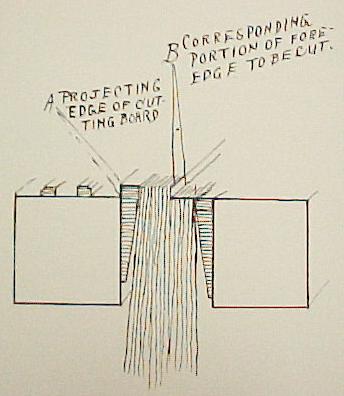
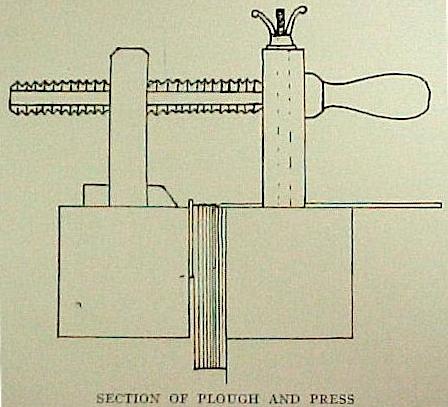
Covering, Protecting the sections while covering (capping):
When ready to put in leather it is judicious to enclose the sections in a cover to protect them from accidental soiling by paste, etc. This is easily done by taking a piece of white or thin manila paper (flexible) about twice the length and breadth of the volume when closed. With the book lying closed on the bench, slip the long edge of the paper between the lower cover and the sections (the end-paper may also be left outside) close up to the joint. The paper at head and tail should project enough to meet or overlap a bit (when folded) at center of book. It should extend beyond fore edge enough to cover the same and reach the joint when folded.
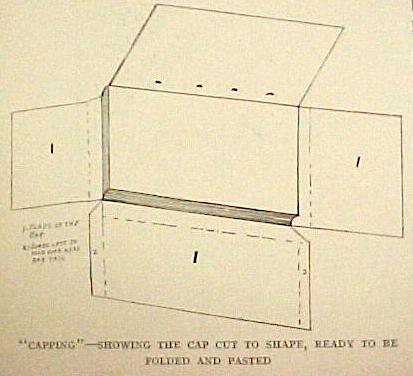
The paper being in position, lay back the upper cover, fold paper over fore edge of sections and cut so that it will not quite reach the joint. Hold it tense and run the finger along the upper edge of the sections, to crease it. Let it go and make a similar crease on ends at head and tail. These creases act as guides in cutting. By consulting the diagram herewith no one should have difficulty in making a neat cap. The part folding over the fore edge is cut somewhat longer than the sections. This extra length is folded down on head and tail (for extra protection) before the ends are folded down and pasted. This “cap” should be snugly fitted before being pasted, so it will not slip off easily. It is usually best to leave the outside leaf of end-papers outside the cap. The correct title of book with date, etc., should be written on the waste end-paper before putting on cap.
Putting in leather:
Select a firm piece of leather and cut it the proper size. When a book is put in full leather it is usual to leave enough margin so that when it is turned over inside the cover, there will be a margin of about one inch on the inside. The most accurate way to measure is to cut a strip of stiff manila paper about one-half inch wide and fold it around the book (between the bands), creasing it over the front edges of the boards. By means of a pair of compasses, one inch is to be added at each end and the paper cut at these points. This will give a very precise and unyielding measure for the length of the leather.
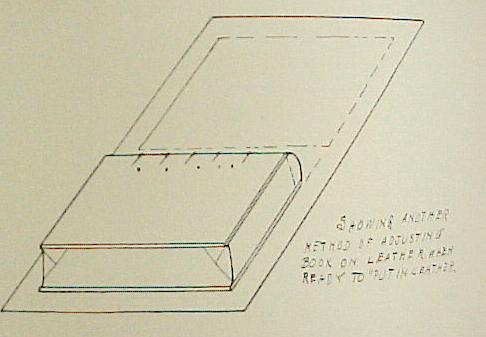
Another strip of paper is then laid on one cover from head to tail and creased at the upper and lower edge. With the compasses an inch is again added at each end and the paper again cut. This will give the width of the leather. By adopting this method a very precise and unchanging measure is arrived at and mistakes are avoided. After the leather is cut to correspond to these measurements, a line is drawn from top to bottom at the exact center where the back of the book is to come. This line being taken as a base line, two other parallel lines are drawn equidistant from the center line -the distance of these lines from the center line varies, of course, with the thickness of the book, but they should indicate just where the edges of the back will come. (It is best to measure the width of the back in the same manner with a strip of paper.) Other lines are drawn parallel to these, indicating where the front edges of the covers will come. Similar measures are taken at the top and bottom, and we then have a gridiron, indicating exactly the width of the back, and the-width and height of the sides of the book. As the leather covering the back will stretch somewhat when being applied, some allowance must be made so the line at the fore edges will come exactly to the edges of the boards and not fall beyond them.
Paring leather:
The lines of the back and sides having been accurately outlined in pencil, lay the leather on a paring stone (any hard, polished surface, stone or metal) and with the ordinary paring-knife, held at an angle of about 45 degrees, make a shallow cut along one of the lines, but be sure not to cut through. Do not try to pare off the whole width, but cut or dig out a shallow trench, so to speak, along the pencil line, to about the depth the paring is to go. Then holding the leather in place with the left hand, the knife held almost flat on the leather (the point in the groove already cut out), shave off part of the thickness to be pared. After the leather has been pared on one edge of the cover, by running the finger over it one is able to tell by the “feel” whether it is about the same thickness all along. The French knife may be used toward the finish to remove any inequalities, holding it quite flat on the leather. In the cut is shown how a cover is laid outalso a section of the leather after it is pared.
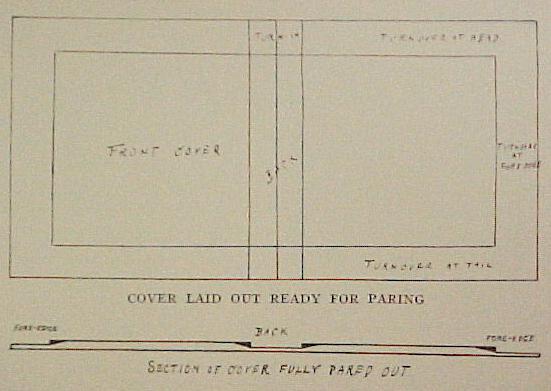
After the back and edges have been pared to the shape and relative thickness shown, then those portions shown in black should also be pared off. This is easily done by running the sharp-pointed paring knife along each groove. These strips are removed so as to make the thickness of the leather decrease gradually and not so abruptly as would otherwise be the case.
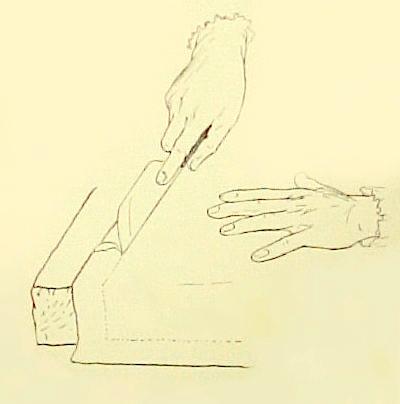
Covering:
The leather being ready for putting on, it is thoroughly moistened with water (on the right side) so that it will be flexible. After this has been done, it is pasted on the inside with thick paste well rubbed in. It should then be folded and left for a short time. The book itself is then taken, and raising each cover at an angle of 45 degrees, a little paste is slipped under each cord (with the point of a folder), the cover then being closed and the paste rubbed in the cord thoroughly with the folder. This is done so that the cord will stick closely to the board as well as to the leather. The book is then rested on the table on its fore edge and the back thoroughly smeared with a finger of paste, especially around the bands. Surplus paste should be carefully removed. The boards are then adjusted so that the squares on each side at the head and tail are the same. The cords in the grooves are then rubbed down again with a folder.
The pared cover is now spread on the bench, the back placed on the leather exactly in the space intended for it, noting that the center line on the cover is exactly in the center of back, and the latter at equal distances from the head and tail of covers Holding the book steadily with the right hand the leather is raised with the left hand and pressed firmly against the side of the book (care should be taken that the book does not slip during this operation). The same is done with the other side of the cover. The book is now placed carefully on its fore edge, the two hands being placed firmly on each side, the leather drawn down firmly and evenly, so that it is brought in close contact with the hack of the book. [covering.jpg] It is necessary during this operation to make allowance for enough leather to cover the bands without stretching it too much. This is done as follows: With one hand on each side of the book (still standing on its fore edge with tail towards the worker), the leather is drawn in by the fingers, from the head, so that it wrinkles somewhat over the back. The book is now reversed and the leather drawn in from the tail.
After this is done it may again be drawn down on the sides, the book still on its fore edge. After the leather has been evenly distributed on the back, the book may be laid on its side, a piece of tough paper, or a smooth piece of skiver, laid on it and with a straight-edge folder the leather is smoothed evenly on each side. By inspecting the edges from time to time the worker notes whether the lines on the leather exactly match the edges of the boards; if not, now is the time to adjust them. Never rub damp leather except through a protective, such as paper. At this point it is necessary to pinch the leather close around each band with the band nippers. Care must be taken that the bands are perfectly straight across the back. After having pinched the bands tightly, a flat piece of wood, narrow enough to go between the bands, is used for the purpose of pressing down the leather between the hands. This operation and that of pinching the leather around the bands must be repeated from time to time, because it takes considerable manipulation to make the leather fit smoothly and adhere to bands and back.
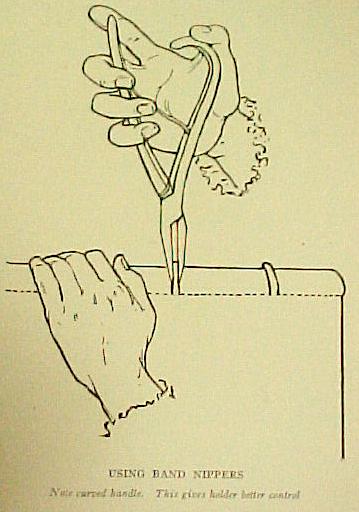
These manipulations consume considerable time, and it is necessary to moisten the leather, both on the back and around the edges, from time to time (by means of a sponge dipped in water) in order to keep it as flexible as possible.
After having smoothed down the leather on the back and sides a number of times and having pinched the bands until they retain their shape, we come to one of the most troublesome operations in covering, that is, the turn-in at the head and tail of the book. It is well to be very deliberate in covering so far as we have gone, in order to give time for the paste to “set” to a certain extent so that the leather will not separate from the back during the next step. Taking the book by the fore edge, the leather which is to be turned in and form the cover of the head-band is to be moistened with some fresh paste, and a small amount of paste is also to be rubbed on the inside of the boards just to the right and left of the head-band. The book is again taken by the fore edge, both covers open slightly, and the book itself stood on its tail on a small stone or block about an inch in height and not over-wide (the sections only resting on it, but not the boards), with the upper part of the fore edge resting against the operators chest to steady it. One cover is to be taken in each hand, opened at right angles to the book, the thumbs on the inside of cover next the head-band and the rest of the fingers at the middle of the back. The upper part of each cover is then pressed back by the thumb until it is slightly beyond the level of the back of the book (the two covers forming a straight line at right angles to the book); the leather which is projecting beyond the edge of the boards is turned down on the inside of the boards and behind the back of the sections, thus making a double thickness of leather behind the head-band. (A very thin narrow folder may be used to smooth out any wrinkles where the leather is folded on itself.) Great care is necessary in this operation in order not to have the leather come loose all the way down the back, thus allowing the boards to change their position in relation to the sections. Great care must also be taken to have the leather which is turned in on the back lie smoothly and not in wrinkles. After this has been successfully accomplished and the leather is turned in at the back of the head-band, it should project beyond it about one-eighth of an inch or somewhat less.
The book is now closed, laid on its side with the fore edge toward the operator. With one hand between the sections and the lower cover, the book being opened at an angle of 45 degrees, the leather on the upper edge of the board is firmly turned in, drawn on the inside of the board as tightly as possible and smoothed down. It is very necessary at this particular juncture to see that the leather is turned down as tightly as possible at the hinge, and if necessary pushed against the inner side of the board (in the joint) with the pointed bone folder. The folder is also to be run firmly along edge of the. cover, pressing the leather against it as tightly as possible, in order to make a good square edge. The same operation is to be gone through with the other cover. If it is now found by inspection of the back that the turned-in leather, instead of lying smoothly, is wrinkled, this can be helped by standing the book up, partly opening the covers and slipping a very thin, narrow, bone folder between the back and the leather and by a little gentle manipulation smooth out the wrinkles.
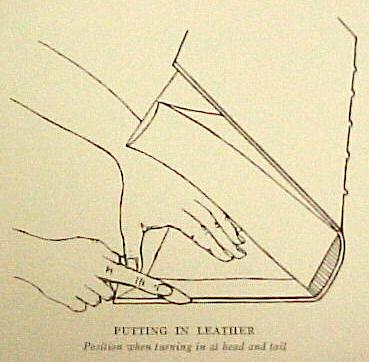
This same operation must be gone through with at the tail of the book. Great care must be taken to push enough leather down into the joint, both at head and tail, to allow the book to open easily. Now turn in each fore edge by itself, the book lying on its side and one hand being placed between the sections and the cover on which work is being done. The fore edge in particular should be smoothed very firmly with the folder, in order that the edges of the board when finished will be sharp and not rounded. No covering for the leather is used when it is being pressed against the edges with the folder.
Turning in the corners:
is a very nice operation, and various methods have been devised; in my opinion the best being to cut the corner off on a slant, as indicated in the cut, by means of the pattern shown. This leaves approximately enough leather to make a good corner; the overlapping portion comes from the fore edge. A few experiments in fitting corners will show the student how much to allow for this and how the edge should be cut and pared to make it fit firmly and evenly. The corner, when finished, should not be thicker than the rest of the cover. Another method (advised by Cockerell) is as follows: The leather at the corner (not pared) being very damp, is pulled well over from both edges and drawn well over at the extreme corner; the surplus leather makes a fold, when pressed together over the line where the miter finally comes. Pressing it well together, say with two folders, the surplus is cut off with a pair of shears; the outer end of the cut should be at least one-eighth inch from the corner of the board. One edge should be pasted down and the other one over it, making a double thickness of leather. It may be necessary to pare the leather a bit at the point nearest the corner, but a little manipulation with the end of a pointed folder is usually all that is needed to make it lie properly for the time being. After it has dried thoroughly the corner may be mitered (say next day) by using a straight-edge and a very sharp-pointed knife held on a slant. Care must be taken that the cut begins say not less than one-eighth to three-sixteenths of an inch from the corner, in order that there be no chance of the latter becoming exposed should the two edges of the miter ever part company. After making the cut, dampen the leather, raise the edges and adjust them so there will be no signs of a joint. While some hinders make exclusive use of this method, I think the majority prefer the method described first as being stronger and less liable to become damaged later in the life of the binding.
The leather has been properly turned in, it will be necessary to dampen it at the head and tail, in order to shape the leather over the head-bands. It will be remembered that the inner corners of the boards were trimmed off; that is, a little wedge-shaped piece at each inside corner at the hinge had been removed. This is done in order to give room for the extra thickness which is caused at this place by the turning in of the leather. Placing the book on its side, with the leather well dampened, a folder is pressed into this V-shaped space, rather deep, making a well-marked crease. After this has been done on each side of the head, the book should be held upright, with the fore edge pressed against the chest and with a flat folder, the leather which is still projecting above the level of the headband is pressed over the top edge and should then lie flat with the upper edge of the boards. There should be enough of this leather to cover the upper edge of the head-band and the turned-over portion should be the same width all around. After this has been done, the point of the folder should be inserted at the end of the head-band and the leather pushed out so that the upper edge of the leather covering the head-band will he pushed out level with the board, the finger or another folder being held against the crease already made, to prevent it being pushed out. This process needs to be repeated several times, in order to get the leather properly shaped and to make it lie smoothly. It should be kept quite damp up to this time. The same operation is repeated at the tail of the book, so that the two ends are duplicates. After this has been done, the book may be stood up on its tail on a flat stone, and with a square wooden rod, which lies flat on the stone, pressure should be made against the tail, just over the headband. By holding the book firmly on the stone and pushing it slightly away from the operator and at the same time bringing pressure to bear against the leather with the wooden rod it will be found that the leather is made absolutely smooth and regular all around. Treat the head in the same manner.
Tying up:
After the head-band has been properly formed and the creases on the side of the book made permanent, it must be left to dry; but before doing this it is necessary to “tie up” the book, in order that these creases retain their shape. Open each cover slightly, slip a piece of thin, stiff water-proof paper (such as is used in copying letters), slightly larger than the cover, between each cover and the book, care being taken that it goes well up to the joint, but not enough to interfere with the final “tying up”. The only object in using the sheets of water-proof paper is to protect the leaves from contact with the damp, turned-in leather and the consequent “crinkling.” Laying the book on its side, with the back projecting over the edge of the bench, a piece of very fine linen thread is selected (long enough to pass around the book at least twice). Holding one end in one of these creases, the thread is run around the book snugly, so that it lies firmly in each one of the four creases made (at the joint). The first turn around will hold the loose end, and after taking one more turn at least, the other end is pushed under the threads and slipped down into one of the creases until it is firmly held also. The book may then be placed between two pressing boards, under slight pressure, or it may he stood up on its tail for this purpose; if placed between boards the result will be better, inasmuch as the covers will remain quite straight.
After an hour or two has elapsed, the thread is removed, one board opened at a time, to note whether the hinge is well set and works well. This should be carefully done and note taken whether, when opened almost flat, the inner edge of the board lies close to the edge of the joint, or whether it is raised up by the leather; if this is the case the inner edge of board should be thoroughly rubbed down with a heavy folder. (During the various processes of covering one should from time to time rub down the leather along the joints outside, as it is most important that it should stick tightly along the joint.) The rising up of the board may be due also to the leather not having been pared out enough; in other words, there is too much leather in the joint. This cannot now be remedied, except it may be well moistened on the outside and well-rubbed down as above. The joint may remain clumsier and stiffer than it should be. After each joint has been attended to in this manner the book should he run over again, smoothing the leather on the sides and back, pinching the bands, going over the folds of the head and tail. Now take the book carefully, the fore edge up, press the back (bands) on a flat stone and by moving the fore edge backward and forward roll the bands on the stone. This not only flattens out the damp leather on the bands and renders them more nearly square, but makes them (or should make them) all of the same depth. It should now be again carefully tied up. The forwarding now being completed, the book should be placed between pressing boards under slight pressure and left at least twenty-four hours to dry. Before putting the hook away to dry, it should be sponged off carefully to remove any paste which may be left.
Design & Tooling Design:
There is no question but that the design itself is of as much importance as the quality of the work. A striking but simple design, based on sound principles of art, is much more valuable and much more effective than more elaborate work done in a haphazard and in artistic manner.I think it will repay every beginner to acquire some knowledge of the principles of design and to continue the study, especially endeavoring to get reliable information on the special principles which should govern every design made for use in bookbinding. As in the engraving of tools, it is necessary that the maker of designs for bookbinding should know the limitations of tools and their combinations as used in this work. A prominent architect who was formerly much engaged in designing book covers and type lays down these opinions:
Tool forms should be clearly manifest, no matter how intricate their combinations. Richness of design is readily obtainable without over elaboration. The fewer the number of tools used, the better.
Ornament should always be subordinated to use. Modern rather than historical designing should be encouraged. I quote in this connection, also, some remarks made by Mr. Philip Mason, of the Riverside Press, Boston: “I find the ‘architectural point of view’ -if I may so name it- a valuable one in the application of ornament to leather-bound books.
First of all, I believe that the designer should himself be a practical ‘finisher’. In no other way can thorough appreciation be had of the possibilities and limitations of the tools themselves, which are the component parts of the design. The design should be made with the tools. But ability to sketch freehand is of the greatest advantage in making ordinary patterns. Very much the same conditions which make for restraint and orderliness in architectural detail will be found to apply in the decoration of bindings.
Varying ‘textures’ and contrasting degrees of reflection are desirable and beautiful in gold tooling. The relation between the decorated and the undecorated surfaces should be carefully studied. Not infrequently, in an ineffective design, the unpleasant shape of the undecorated surface asserts itself in a way damaging to the decorated surface considered as a whole. It is a question whether the most pleasing of richly decorated bindings are not those whose elements of design-in other words, the ‘tools’are few in number and simple of form. Application of design (blinding-in): One of the principal things to be observed in the application of a design is to have it square on the board-that is, the outside lines should be absolutely parallel with the edges of the cover, which I note is frequently not the case. The slightest deviation from absolute parallelism will be apparent when the work is finished. It is not advisable, therefore, to “blind-in” the outside line or lines through the pattern. This outside line or lines should be marked on the leather itself with compass and folder and should be “blinded-in” separately. The paper pattern should then be cut to fit this line precisely, laid on the cover, and held by a weight at center; several spots at edges and corners should be touched with paste and the edges then pressed into the lines already made.
After it has dried, each portion of the design should be gone over with moderately hot tools-a moderate amount of pressure being used. After this is done one side of the design should be loosened by running the folder under the edge (after the pasted spots have been moistened), so that the worker may assure himself that all parts of the pattern have been impressed on the leather. After the whole pattern has been impressed the design is removed, great care being taken to immediately wash off any paste spots which may be left. The whole pattern has then to be gone over again with tools which are quite hot, being careful to apply them accurately in order not to “double” the pattern. After having gone over them a second time, it will be seen that the pattern is very clearly indicated, and it is now ready for the final “blinding-in”. Up to this point you will note that the leather has been worked in its dry condition. Careful inspection will show that the leather just outside the edges of each impression is “pulled down” toward the impression, instead of being at its normal level, and making a clear cut impression for each part of the design. In order to correct this and to render permanent the impression already made, it is necessary to dampen the design with vinegar, allowing from fifteen to twenty minutes to soak in thoroughly; the whole pattern is now worked over again, this time with more care, if possible, than before, and with tools which are not too hot to rest against the hand.
Much care must be taken as to the heat of the tools during this operation, because the slightest excess of heat, combined with pressure, will cut through the leather, or at least burn it, so that the pattern may be spoiled. The principal reason why it is necessary to moisten the leather and go over the pattern again is, that if this is not done, the impression “blinded-in” on the dry leather would almost fade away on the application of any moisture, such as “glaire,” or at least become so indistinct that precise tooling would be impossible. It cannot be too forcibly impressed on the worker that careful, precise “blinding-in” is absolutely indispensable. The final results of thorough “blinding-in”, over careless work, are very similar to the results attained by the careful as against the careless cultivator. The one cultivates his land thoroughly, going over it again and again, to put it into the very best condition for producing good crops. The other is satisfied with careless preparation of the ground, and the result is that his crops not only are small, as regards quantity, but poor, as regards quality. The same thing applies to thorough and superficial work as regards the operation of blinding-in. Blinding-in of back: All designs for panels of back should be laid out from a central perpendicular line.
Having laid out the pattern, the paper is cut at top and bottom of panel, three and four inches being left at each side. Place the book- a pressing-board on each side-in the finishing press. With a folder make a slight mark on each panel at the exact center of back. The paper strip with panel design is now laid across one panel and the center line of the pattern adjusted accurately to the guide marks just made on the latter. Holding it firmly in place, the ends of the strip are touched with paste and fastened to the sides of the pressing-boards. It is now blinded-in, and the other panels treated the same way. The lettering on the back should also be laid out accurately on a similar strip of paper and blinded-in most carefully; much care should be taken to have it in the exact center of the back. Blind tooling: This is also known as “antique” monastic style. Blind tooling is simply blinding- in the design (as if for gold work), and instead of using gold, changing the color of the leather itself (in the impressions) to a brown or black. This is done by dampening the leather after the design has been impressed and going over the damp design again and again with tools warm, but not hot, the object being to outline the design either in brown or black. This is really done by singeing or scorching the leather under the tools. The color and depth of the pattern or design should be uniform over the whole pattern. When the blind tooling is completed, let the cover dry thoroughly, and then work the design again with tools much hotter than before; this polishes the leather in the impressions.
Curves
FINISHING: Tools & Supplies, continued Gouges:
An indefinite number of these may be had of various curves, lengths and widths of line. I advise the beginner to secure them only as they are needed in the development of his skill. The diagram herewith gives an idea as to curves and lengths to be selected from time to time.
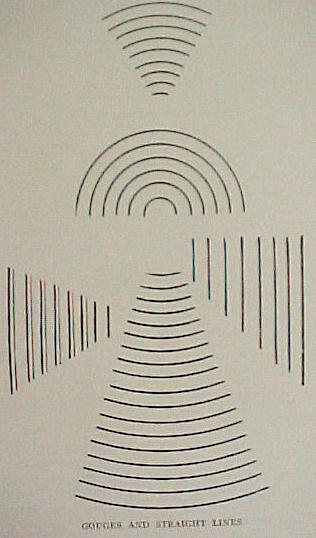
Lettering:
This may be done by separate hand letters or by means of a pallet and type. Both methods have their votaries and both have advantages. Both also produce good results in the hands of experts, and both may produce poor results in other hands. So one may select the one he prefers. In the United States, type is used in most professional work. Hand letters are used by English binders, and in this country they are employed by those habituated to their use by study abroad. Type is less expensive, and one may have a greater variety for the same outlay. The respective cost is about as follows: A first-class pallet of good size.. $6 to $8 Four fonts of type (brass) $20 to $25 Lead type, coppered, may be used, and costs from $1.50 to $2 per font. Type, both lead and brass, are put up for binders in fonts of 100 letters. Brass type is by far the best, and if possible the foreign article should be bought. Handle letters cost from $1o to $12 per set of 24, plus figures. As good a binder as Cockerell says one may get along with four sizes of type. I know, however, that some binders doing all kinds of work have a dozen different sizes and styles. Assuming, however, that four sizes are a happy medium, the comparative cost will be about as follows: Pallet, $8; four sets type (brass), $24…………… $32 Pallet, $8; four sets type (lead), $6………………$14 Four sets handle letters ……………………………….$45 The matter of expense usually settles the question, in the case of most beginners. Both type and handle letters made in Europe are about one-half the price and better made, so the opportunity of getting suck things abroad should not he neglected. Brass type may be found in Europe cut specially deep for binders’ use. Recent comparison of such type with the commercial brass type made here, shows the depth of cut of the latter to be not more than one-half that of the foreign make.
Arrangement of tools:
The various fillets should be held on the wall by means of a rack like this: the cuts being about one inch in depth and just wide enough for the shanks of the fillets. It has been customary to keep finishing tools on shelves or in cases provided with a special space for each tool. This is a very good method, but is costly and takes up much space. After considerable thought and experiment I finally settled on the following expedient: As the average tool is less than 10 inches long, I took a box say 9 by 14 inches by so inches deep, open on one side. This I filled with brown paper mailing tubes s inch in diameter and 6 or 8 inches long, tightly packed. Each tube holds one tool securely, preventing abrasion with its neighbors and presenting its face for inspection. A box, 9 by 14 inches, holds about 140 one-inch tubes, consequently 140 tools. The entire expense is one and one-half dollars. The usual racks for the same number of tools cost many times that and take up many times the space. This method is also most useful when need arises to transport a lot of tools for the summer or for demonstration in another place, etc.

Gold leaf:
There are many qualities of gold leaf in the market -only the best should be used. While it is well to be economical in the use of all supplies, never hesitate to use plenty of gold, for on this, to a large extent, depends the brightness of the tooling. The most brilliant gold of domestic manufacture is known as French No. r. A box, containing each 25 books, costs at this date between seven and eight dollars, and lasts a longtime. Single books of twenty-four leaves retail at from thirty-five to forty cents each. The very best quality of gold is the French color “citron”. French gold costs almost double the price of domestic. The sheets are a bit larger, however, and thicker, and it is of a higher fineness, so that the real cost is about the same, and it should be used in all high-grade finishing. Finishing blocks: These are most useful in tooling, and I call them by this name, though they are in daily use for many other purposes, as, for instance, cutting and pasting down end-papers, etc. The upper surface should also be covered with skiver.
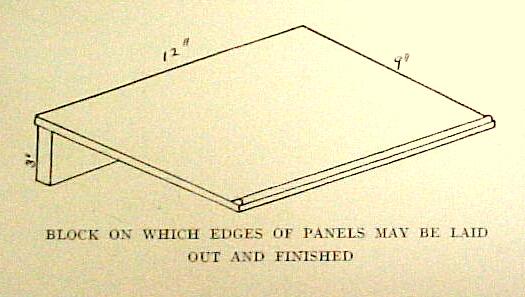
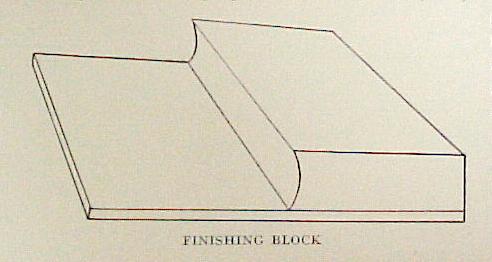
The simplest tools are the most satisfactory. Leaves, buds, flowers, should all be separate tools; sprays, flowers with leaves, etc., all on one tool may be useful for rapid work, but in the end they are less useful. The simple elements (if each is separate) can be combined in a hundred different ways not possible when in fixed combination. Tools with a large surface should be avoided. A single tool having a superficial area greater, say, than one-half inch square, is difficult to use because of the strength needed to make a bright, clear-cut impression. On some leathers, which may be hard and unyielding, such tools result in very unsatisfactory work. It is very unsatisfactory, also, to use tools made after the stock patterns which are shown in print by the various tool-cutters. As few tools are ever kept in stock, it is almost always necessary to have them cut, so it is no more expensive to have one’s special ideas reproduced, than to have stock patterns cut.
The binder should be able to make a drawing to scale, indicating in a general manner at least, what pattern is wanted. While small tools, such as leaves, small buds and flowers, may be quite flat on the face, the larger tools should be slightly rounded, as it is desirable to rock them from front to rear slightly to get a firm pressure on each part of its surface. This rounding should be very slight, however. As each tool is marked on one face of the shank, the binder should early acquire the habit of using the tool with this mark pointing away from him when used. It will also be convenient to get into the habit of having this marked side of the tool when in use to point towards the bead of the book.
Unless one has some general habit of this nature, it is not always easy to remember which way the tool was applied when it was usedsay for blinding-in. While conventionalized flowers, for instance, may have each petal a duplicate of the others, there are always minute differences, so that the best results are attained if some general rule is followed by which the tool is always impressed with the same part of it coming just where it did when the original impression was made. Tools as received from the engraver may perhaps be used, but it is always best to inspect them carefully with a good glass to note whether the sharp edges have been rounded offno sharp edges should be allowed.
Fillets, gouges, lines, dots, circles, etc., may be rubbed with very fine sandpaper or emery cloth, enough to round slightly the sharp edges felt when the finger is pressed firmly on the margins. The amateur in the country, or where no engraver is readily available, may be obliged to make many simple tools, such as straight lines, dots, squares, diamonds, etc. All that is needed is a small vise, a few files, sandpaper, emery paper and some pieces of brass rod-round, square or oblong as may be. A person with ingenuity can in this manner help himself out of many a difficulty. The beginner should be careful not to have finishing tools made by an engraver not accustomed to such work.
Many a good engraver may know nothing of the limitations of finishing tools and may produce tools which cannot be used at all; or, if used, work unsatisfactorily. I recently saw a set of tools made in a Western city for an amateur, all of which were so clumsy that they must be re-cut before fit for use. Lines, fillets, gouges, etc., should not have a section of wedge shape, but the two sides should be quite parallel; at least that portion which is pressed into the leather. Fillets: These are made of various sizes; 3 to 3.5 inches in diameter are most useful. Smaller ones are in use, but experience shows that it is easier to follow a straight line with the large size, and becomes more and more difficult as the size diminishes. As a rule fillets are found in stock with one side quite flat and the other a curve, as indicated at (a). Before purchasing, have it put in the lathe and the edge turned to the shape shown at (b).
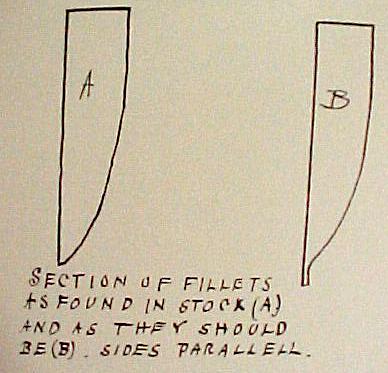
Rolls:
These are fillets with wide surfaces, on which an ornamental pattern has been cut. Good binders do not use them, because they do not wish to use the same pattern on more than one book or set of books. Another objection is, they are quite expensive. Tools with rounded edges produce more brilliant results than if the edges are sharp and the face quite flat. This is especially the case in straight lines, curves, dots, etc. This is because a fiat, gilt surface is not so good a universal reflector as a curved one. A tool with a sharp edge and flat surface makes a depression in the leather which, in section, looks like this: With edges smoothed off and the face (say of a line) rounded, the sections like this: – In the first instance the only reflecting surface is A, and it is only bright when in one special relation to the eye. In the second case the reflecting surfaces are at B, and are brilliant in some one part at all times. Multiplying this difference by the hundreds of points of reflection in the average design, it may easily be seen that one method produces a more brilliant effect than the other, irrespective of the quality of material or work. The following styles are ample for a beginning:
Fillets: Single line, light. Double line, light. Single heavy line. Double heavy line. Very heavy and light combined.
Straight lines: 1/4 and 1/2 inch and 1 inch long should be secured to match each of the fillets, the lines being of the same width.
FINISHING: Gold Tooling “Striking” the tool:
If the “blinding-in” has been done carefully, it will be found that the edges of each impression are quite firm and act as a guide for the tools, so that in a very short time the operator works as much by the “feel” of the leather as by his eyesight. After all that part of the pattern to which gold has been applied has been worked over with the tools, the surplus gold should be removed with prepared rubber or with an oiled rag. After this has been done, the pattern should be rubbed over very thoroughly with a pad of fresh, loose, absorbent cotton. This penetrates into the depressions enough to remove all the ragged edges of gold which may still be present. It will then be seen whether the operation has been a success or not. It may ke that some portion of it has been slightly burned, or at least the tool has been somewhat too hot to give a bright impression, which is shown by the frosted appearance which gold has under such circumstances. Other spots may show that the tool was not hot enough, in which case the gold will not stick and may disappear partly or completely when the rubber is used.
The whole surface should be re-glaired and retooled, and this should be repeated until it is satisfactory. If the design here and there is scorched, or if, after several attempts, the work is not satisfactory, it should be washed out entirely with vinegar; sponge it out first and clean out the depressions more carefully, say with the pointed end of a soft wooden match, wet in vinegar. After washing out, it may be glaired again while still moist, but should be left until next day to dry out, and then before tooling glaired again with very thin glaire. If, however, the finishing already done seems to be satisfactory, it should be glaired again carefully. While the glaire is drying another small portion which has already been glaired-in and is dry should be now tooled in the same manner. Tooling a second small portion of the design in this way takes up some time, so that the part first worked (and which has been glaired-in again) is now dry enough to be retooled.
As a rule, it is unnecessary to do the tooling more than twice, but leather is of such different degrees of firmness and quality that it is sometimes necessary to go over the same spot three or four times. In this connection it may be said that the beauty of the work done by the French binders is due not so much to the quality of the materials used as to the fact that almost all their work is gone over time after time, until the tooling is absolutely “solid.” I advise the beginner not to cover too great a surface at a time, but to work very slowly in small sections, and to complete each section before beginning a new one.
Tooling a large surface and leaving it in an imperfect and unfinished condition results in one’s losing interest in the work and not finishing it in proper manner. “Make haste slowly” is of more importance in this branch of procedure than anywhere else.) When the tooling of any one day is finished it should he thoroughly sponged with a pledget of absorbent cotton soaked in benzine. This is particularly necessary in leathers of delicate shades in order to remove the stains of the oil. This washing with benzine has no effect on the tooling itself (providing it is properly done).
Lettering:
The title and the name of the author are the two things which are the most important and to which the design used on the back should be subordinated. The lettering should stand out plainly and at the same time not be out of proportion to the panel decoration. As books vary much in thickness and as the thinnest hook may have a very voluminous title, it often taxes the worker’s ingenuity to make a harmonious arrangement. In very thin books it may be found necessary to have no raised bands at all, the title covering the whole length of the back in a single line. In such cases, handle letters should be used. The size of type used must, of course, depend on the length of title and the thickness of the back. As a rule, type of larger size may be used in this style. For an ordinary back to (3/4 to 1 1/4 inches) it is better to break long words or divide the title in several lines, properly proportioned, thus using a larger size type than would otherwise be the case. It is customary to place the title in the second panel, the author’s name in the third. Many binders, however, skip one panel and place the authors name in the fourth panel.
Often both title and name are placed in one panel (second), as one well-filled and well-proportioned panel is more decorative than two rather scantily filled. This should, however, never be done at a sacrifice of legibility. It may be accepted that lettering on backs appears at its best when it is laid out by taking a perpendicular line through the center of the panel as a base line, the lettering being equal in amount on both sides of the line. Some binders begin all words near the left edge of the panel, filling out the vacant spaces on the right by stars or dots corresponding to letters. If well done, it is very effective and appropriate in suitable cases. Experimenting with a given sized panel and a selected type (or handle letters) is the only way in which the beginner will acquire a definite knowledge of the little difficulties which surround this particular branch of work. In experimenting on paper, however, it should be borne in mind that the type should be separated a trifle more when used on leather. Spacing the type is also useful for making a given word cover a slightly longer space.
Preparing for Finishing:
After the book has been brought thus far-that is, after the leather cover has been put on-the forwarding is complete and the book is ready to be “Finished.” This term includes many processes; each will be taken in order and briefly described.
Filling in:
As the book now lies before the worker, the inner sides of the covers have an irregular strip of leather around the edges of a greater or less Width. This must be trimmed to an exact width and the level of the board in the center brought up to the level of the leather at the edges. With the compass take the width of the narrowest part of the leather margin, and, fixing the legs of the compass firmly, a line is drawn along each edge and parallel to it, and by means of a straight edge and sharp knife, held perpendicularly, the leather is cut to the same width all around. The central portion of the board is now filled in with several thickness of a porous paper (called card middling), one pasted on top of the other until the level is brought up to that of the leather, so that when the finger is s-un over the joint there will be no apparent difference. The best way to do this filling in (these remarks apply to a book without a leather binge) is to ascertain by experiment just how many thickness of paper are needed for the purpose; then fold that number of sheets together to a size slightly larger than the space to be filled in (but not so large as the cover itself). The cover lying open on a finishing block, place these sheets over the space to be filled in, with a weight. at the center; the same compass (spaced for cutting the leather edges) is used to mark points around the edge which will correspond exactly with the width of the leather. The sheets are then removed to the cutting board, care being taken not to disarrange them, and all are cut at one operation; it will be found that they will fit the space exactly if this has been carefully done. Before pasting them in, however, it is necessary to allow for a small amount of expansion when they are dampened with the paste, and it is therefore necessary to cut a narrow sliver from the top or bottom. A little experimenting in this direction will show what is necessary. As the filling paper lies before the worker, it is cut squarely on three sides-that is, the head, the tail and the fore edge, and fits the space exactly. It should be wide enough to extend a quarter of an inch beyond the inside of the board itself. Each piece of paper, as it is pasted in place, should he thoroughly smoothed down with a folder (through another piece of paper). This smoothing down should be particularly well done at the inside edge of the board. After they have all been pasted, one on top of the other, the board should be left open for a few hours to dry thoroughly, so the filling in may draw the board enough to counteract the drawing of the leather on the outside. After it is thoroughly dry the paper will be found to be quite unyielding at the inside edge; take a sharp, pointed knife, and, running it along the inside edge of the board (edge up), the various thickness of the paper are cut through, making them quite square with the inside edge of the board. The book is now ready for the real work of “Finishing”.
Paste-washing:
The covers-especially if the leather be at all porous-should now be thoroughly “paste-washed” as follows: Mix a little paste with water, making a thin, milky solution which feels rather sticky to the fingers, and wash the leather once or twice and let it dry. This is done so that the minute interstices of the leather may be filled up, thus helping to render absolutely smooth the surface on which the gold is finally to rest. After it has dried it should again be sponged off with water, or preferably vinegar, to remove the pasty feel from the surface. Many leathers have a very rough surface, which surface it is necessary to render somewhat smoother before applying a design, particularly if the latter be composed of fine lines or elements. The leather, inside and out, should be moistened with water or vinegar and polishing tins placed inside the covers; the book should then be placed between a pair of polishing plates and put in the press. The amount of pressure to be used in this operation must be a matter of experiment with each individual worker, but not much pressure is to be used; the leather is not to be crushed, but rather flattened a little. It is not necessary to use much pressure nor to leave the book in any great length of time. Light pressure and a half hours time will answer the purpose. After coming from the press the book should be allowed to dry between a pair of plates with a small weight resting on it; this in order to prevent the boards from warping.
Polishing and crushing:
After the book has been tooled both inside and out and on the back, it must be polished and crushed. Both of these operations are rather lengthy ones. Polishing Plates: The usual material from which polishing plates are made is copper or brass about one-fourth inch thick, and either nickeled or silver plated. One pair of plates of good size, say 9 by 12, will answer the purpose of the average worker. It is, of course, more convenient to have plates of various sizes, but they are somewhat expensive. I am using a pair of plates made of aluminum. These plates have the advantage of being very much lighter in weight, but they also have the disadvantage of not retaining the heat as the more dense metal does. For amateur use, however, where only one book at a time is being crushed, they do very well. Aluminum becomes easily tarnished, so it is necessary to have them plated. I have succeeded in having a pair nickel-plated, but it seems rather difficult to have this done. (Aluminum plates cost much less than of brass, copper, etc.)
The polishing is done with either one of the two polishing irons which are in stock, each portion of the cover being gone over with a polisher which is somewhat hotter than the finishing tools themselves, not too much pressure being used during the operation. The polish is produced with the polisher and not with the polishing plates. After the book has been given the gloss which is desired, it goes through the operation of crushing. In order to do this successfully and evenly, a pair of metal plates are heated on the stove, the degree of heat being about that used in the finishing tools. Two thin polishing tins are also heated, one being placed inside each cover, with perhaps one thickness of clean blotting paper between the tin and the sections. Great care must be taken to have both the blotting paper and the tin go well down into the joint of the book. The tins being in place, the book is closed and laid on one of the hot plates, the other being placed on top of it. The book and plates are now put in the press. To facilitate handling the hot plates and book, I find it well to place a thin board (one-quarter inch thick) outside each plate. Transfer the whole (holding them firmly so no disarrangement may take place) to the press, which is then screwed down securely until a somewhat firm pressure is exerted on the book. It is much better to have too little pressure than too much, and it is well to remember that a very moderate pressure, combined with the heat of the plates, exerts a very great influence on the soft leather.
My own method is to have the plates only moderately hot, bringing a reasonable amount of pressure to bear on the book for a few minutes only, then loosen it up and again screw the press down until the plates just hold the book in place. When placing the book in the press it should be so adjusted that its center lies under the central point of the platen of the press. The book should be left in the press overnight, or at least for several hours, and if it is found that it is not crushed enough -which is not often the case- it can be easily remedied. Too often, however, the beginner finds that the pressure he has used has been so great that the grain of the leather has been quite crushed out, leaving a glossy surface, the gold being thus on the surface of the leather.
It should be noted that one of the objects of proper “blinding-in” is to get the impression deep enough and sharp enough, so that when the book is finished no amount of handling will impair the brilliancy of the gold, for the reason that the whole pattern is sunk below the surface of the leather and is not touched when the book is used. On the contrary, when the “blinding-in” is poorly done, or if the crushing is overdone, the gold is in this operation brought up to the surface of the leather and is open to injury from the slightest cause. Half-bound books: This is a most useful style for library use. The forwarding is in all respects the same as that already described, up to the point of putting in leather. In this case the back and corners only are covered with leather. The leather may extend on the sides as far as may be desired; the only point to be observed is to have the width from A to B the same, or a bit greater than from C to D. Otherwise the corners seem “skimpy.” After the leather has been put in place and has dried thoroughly, it should be cut square and true at the free edges. Now cut a piece of thin mill-board to fit on the outside and cover all of the board not covered with leather. Using this as a pattern, enough filling should be cut to raise the surface level with the leather. The filling should be long enough to cover the edges and the inside edge of the board also if the leather here needs it. The turn-over of the filling should not go further than does the leather. If the inside of the board needs lining as a whole, special filling should be cut for it, just as in full-bound work. When the filling-in has been completed, lines should be drawn on the leather (with straight-edge and folder) about one-eighth inch from the edge. The paper or cloth for covering the board is then cut to fit the space. It should be large enough to come up to the lines above referred to and to turn over the edges of the cover. It may be fastened on with paste or glue; the latter is best, but very troublesome to use until one becomes expert.
Opening a newly bound book:
When both forwarding and finishing are quite done, the binder should “open” the book carefully in the following manner: Open one cover flat; hold a rulers edge upright against the end-paper (fly-leaf) where it is pasted to the section. Open the end-paper and run a folder along the straight edge, thus “breaking” the page somewhat. Do the same to the other end-paper. Now take all the sections, hold them perpendicular, the covers lying on the bench; take two or three sections at a time (front and back alternately), flatten them down and run the hand along the joint, always beginning at the center of back, thus flattening them down as much as possible. Continue until all have been attended to. The book should now be put under pressure againnot necessarily in the pressand left a day or a few days before it is allowed to leave the bindery “Hand-tooled” work produced by machinery: A few words on this modern development may not be out of place. The well-known method of “blocking” has recently been made use of to produce a style of finishing which in itself is quite well enough; it is very objectionable, however, to impose bindings finished by such purely mechanical processes on the guileless public as “hand-tooled” books. These “blocked patterns” are produced as follows: The whole design is engraved on a single metal plate. This is placed in an “arming press” and heated.
The cover with a blanket of gold-leaf (this often of poor quality) on it, is slipped in position, the lever pulled, and “presto!” the pattern is produced. No preliminary “blinding-in” is needed. By this method all parts of the design are stamped to the same depth, and all parts are flat as regards surface. This naturally results in “loss of life” in the design; it is flat and uninteresting, devoid of that individuality which is always present in the simplest specimen of hand-work. In using small tools no two impressions are necessarily at the same angle; this causes the reflecting surfaces of the gold to be active at whatever angle the book is held and thus gives brightness and variety which can never exist in blocked work. It therefore follows that a hand-tooled book, where the design is worked out in small tools, is much more brilliant than where large tools are employed. Some criticism expressed recently, by a competent authority, referring to this variety of work, may be read with profit: In short, it could not give the impress of thought and mind to its work, which render the simplest specimen of true handicraft more or less interesting and satisfactory. Its perfection was a dead level of uniformity, dull and unpleasing, and its limitations of ornamental or other art were pretentious failures. “The remarks “as to flatness” apply also to the employment of “rolls” in borders. They not only make a bad finish at the corners, but they produce a “flat” result, as the whole bearing surface must be on one level; the wider the roll the worse the effect. It is only of recent years that a few unscrupulous publishers have begun to employ this method of exploiting their unwary customers.
The usual procedure is as follows:
A so-called “limited edition” of some well-known standard set of volumes (on which the copyright has usually expired) is advertised and subscriptions are solicited. This is done by clever agents who work almost exclusively among people not familiar with such methods. It is represented that this is in itself a “limited” edition of say 1,000 copies, and that a small number of copies (from ten to thirty) are specially illustrated by original watercolors or line drawings on “specially prepared” paper, specially hand-bound and tooled, etc. When issued as full bound work, the leather selected is sometimes of inferior quality and soon deteriorates. In some cases the machine tooling is eked out by a small amount of hand-work, just enough to give color to the statement “it is hand-tooled.” This business, however, only flourishes among customers who are in complete ignorance as to what constitutes a well-bound book.
There is only one thing to be said in favor of such work, and that is, that even though purchasers are defrauded to some extent, they soon find it out and in the research made necessary by this they do acquire a knowledge of what is the real thing, and in this way many of them become well posted for the future, as to the kind of books they ought to buy. In this manner a considerable knowledge of the art is spread abroad, though in a very objectionable manner.
In closing this article, I desire to express my indebtedness for many valuable points contained herein to the works of Zaehnsdorf, Cockerell, and particularly to the excellent articles published by Messrs. Sangorksi & Sutcliffe, of London. Their articles were illustrated by the best cuts which have so far come to my notice, and I have made free use of them, particularly those relating to sewing and head-banding. I also desire to acknowledge my indebtedness to Bradstreets bindery, its genial superintendent, Mr. John Oliver, and to the expert staff, Messrs. David Smith, forwarder; Nathaniel Kirby and Alfred Launder, finishers, and Miss Doran, who does the sewing and head-banding. To their willingness to give me practical points and to discuss them has been due whatever success I have had so far.
Not being interested in the art of bookbinding in any way except for the love of it, I have felt free to make full use of all accessible data which would aid me in bringing in compact shape before the beginner those points which will aid him in his efforts. If I have done this, in even a slight degree, I shall feel well repaid.
NEW YORK, September, 1907, 346 Broadway.
